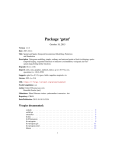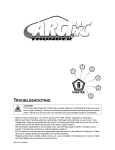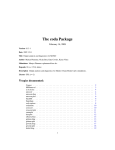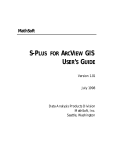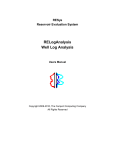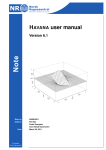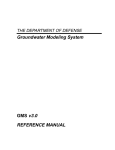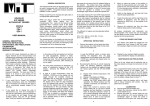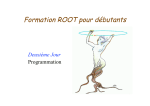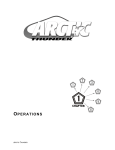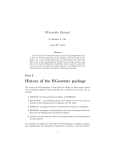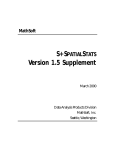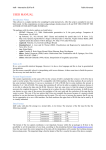Download Package `gstat`
Transcript
Package ‘gstat’ February 19, 2013 Version 1.0-16 Date 2013/02/18 Title spatial and spatio-temporal geostatistical modelling, prediction and simulation Description variogram modelling; simple, ordinary and universal point or block (co)kriging, sequential Gaussian or indicator (co)simulation; variogram and variogram map plotting utility functions. Depends R (>= 2.10), methods, sp (>= 0.9-72) Imports lattice, xts, zoo, spacetime (>= 1.0-0) Suggests rgdal (>= 0.5.2), rgeos, fields, mapdata, lattice, maptools License GPL (>= 2.0) URL http://52north.org/geostatistics, https://r-forge.r-project.org/projects/gstat/ Author Edzer Pebesma [aut, cre], Benedikt Graeler [ctb] Maintainer Edzer Pebesma <[email protected]> NeedsCompilation yes Repository CRAN Date/Publication 2013-02-19 15:39:26 R topics documented: coalash . . . . . fit.lmc . . . . . . fit.StVariogram . fit.variogram . . . fit.variogram.gls . fit.variogram.reml fulmar . . . . . . get.contr . . . . . . . . . . . . . . . . . . . . . . . . . . . . . . . . . . . . . . . . . . . . . . . . . . . . . . . . . . . . . . . . . . . . . . . . . . . . . . . . . . . . . . . . . . . . . . . . . . . . . . . . . . . . . 1 . . . . . . . . . . . . . . . . . . . . . . . . . . . . . . . . . . . . . . . . . . . . . . . . . . . . . . . . . . . . . . . . . . . . . . . . . . . . . . . . . . . . . . . . . . . . . . . . . . . . . . . . . . . . . . . . . . . . . . . . . . . . . . . . . . . . . . . . . . . . . . . . . . . . . . . . . . . . . . . . . . . . . . . . . . . . . . . . . . . . . . . . . . . . . . . . . 2 . 3 . 5 . 6 . 7 . 9 . 10 . 11 2 coalash gstat . . . . . . . . . hscat . . . . . . . . . image . . . . . . . . jura . . . . . . . . . krige . . . . . . . . . krige.cv . . . . . . . krigeST . . . . . . . krigeTg . . . . . . . map.to.lev . . . . . . meuse.all . . . . . . meuse.alt . . . . . . ncp.grid . . . . . . . ossfim . . . . . . . . oxford . . . . . . . . pcb . . . . . . . . . . plot.gstatVariogram . plot.pointPairs . . . . plot.variogramCloud predict.gstat . . . . . show.vgms . . . . . . sic2004 . . . . . . . sic97 . . . . . . . . . spplot.vcov . . . . . tull . . . . . . . . . . variogram . . . . . . variogramLine . . . . variogramSurface . . vgm . . . . . . . . . vgm.panel.xyplot . . vgmST . . . . . . . . vv . . . . . . . . . . walker . . . . . . . . wind . . . . . . . . . . . . . . . . . . . . . . . . . . . . . . . . . . . . . . . . . . . . . . . . . . . . . . . . . . . . . . . . . . . . . . . . . . . . . . . . . . . . . . . . . . . . . . . . . . . . . . . . . . . . . . . . . . . . . . . . . . . . . . . . . . . . . . . . . . . . . . . . . . . . . . . . . . . . . . . . . . . . . . . . . . . . . . . . . . . . . . . . . . . . . . . . . . . . . . . . . . . . . . . . . . . . . . . . . . . . . . . . . . . . . . . . . . . . . . . . . . . . . . . . . . . . . . . . . . . . . . . . . . . . . . . . . . . . . . . . . . . . . . . . . . . . . . . . . . . . . . . . . . . . . . . . . . . . . . . . . . . . . . . . . . . . . . . . . . . . . . . . . . . . . . . . . . . . . . . . . . . . . . . . . . . . . . . . . . . . . . . . . . . . . . . . . . . . . . . . . . . . . . . . . . . . . . . . . . . . . . . . . . . . . . . . . . . . . . . . . . . . . . . . . . . . . . . . . . . . . . . . . . . . . . . . . . . . . . . . . . . . . . . . . . . . . . . . . . . . . . . . . . . . . . . . . . . . . . . . . . . . . . . . . . . . . . . . . . . . . . . . . . . . . . . . . . . . . . . . . . . . . . . . . . . . . . . . . . . . . . . . . . . . . . . . . . . . . . . . . . . . . . . . . . . . . . . . . . . . . . . . . . . . . . . . . . . . . . . . . . . . . . . . . . . . . . . . . . . . . . . . . . . . . . . . . . . . . . . . . . . . . . . . . . . . . . . . . . . . . . . . . . . . . . . . . . . . . . . . . . . . . . . . . . . . . . . . . . . . . . . . . . . . . . . . . . . . . . . . . . . . . . . . . . . . . . . . . . . . . . . . . . . . . . . . . . . . . . . . . . . . . . . . . . . . . . . . . . . . . . . . . . . . . . . . . . Index coalash . . . . . . . . . . . . . . . . . . . . . . . . . . . . . . . . . . . . . . . . . . . . . . . . . . . . . . . . . . . . . . . . . . . . . . . . . . . . . . . . . . . . . . . . . . . . . . . . . . . . . . . . . . . . . . . . . . . . . . . . . . . . . . . . . . . . . . . . . . . . . . . . . . . . . . . . . . . . . . . . . . . . . . . . . . . . . . . . . . . . . . . . . . . . . . . . . . . . . . . . . . . . . . . . . . . . . . . . . . . . . . . . . . . . . . . . . . . . . . . . . . . . . . . . . . . . . . . . . . . . . . . . . . . . . . . . . . . . . . . . . . . . . . . . . . . . . . . . . . . . . . . . . . . . . . . . . . . . . . . . . . . . . . . . . . . . . . . . . . . . . . . . . . . . . . . . . . . . . . . . . . . 12 15 17 18 20 24 26 28 30 31 32 33 34 35 37 38 40 41 43 47 48 50 51 52 54 58 59 60 63 65 67 67 68 72 Coal ash samples from a mine in Pennsylvania Description Data obtained from Gomez and Hazen (1970, Tables 19 and 20) on coal ash for the Robena Mine Property in Greene County Pennsylvania. Usage data(coalash) fit.lmc 3 Format This data frame contains the following columns: x a numeric vector; x-coordinate; reference unknown y a numeric vector; x-coordinate; reference unknown coalash the target variable Note data are also present in package fields, as coalash. Author(s) unknown; R version prepared by Edzer Pebesma; data obtained from http://www.stat.uiowa. edu/~dzimmer/spatialstats/, Dale Zimmerman’s course page References N.A.C. Cressie, 1993, Statistics for Spatial Data, Wiley. Gomez, M. and Hazen, K. (1970). Evaluating sulfur and ash distribution in coal seems by statistical response surface regression analysis. U.S. Bureau of Mines Report RI 7377. see also fields manual: http://www.image.ucar.edu/GSP/Software/Fields/fields.manual. coalashEX.Krig.shtml Examples data(coalash) summary(coalash) fit.lmc Fit a Linear Model of Coregionalization to a Multivariable Sample Variogram Description Fit a Linear Model of Coregionalization to a Multivariable Sample Variogram; in case of a single variogram model (i.e., no nugget) this is equivalent to Intrinsic Correlation Usage fit.lmc(v, g, model, fit.ranges = FALSE, fit.lmc = !fit.ranges, correct.diagonal = 1.0, ...) 4 fit.lmc Arguments v multivariable sample variogram, output of variogram g gstat object, output of gstat model variogram model, output of vgm; if supplied this value is used as initial value for each fit fit.ranges logical; determines whether the range coefficients (excluding that of the nugget component) should be fitted; or logical vector: determines for each range parameter of the variogram model whether it should be fitted or fixed. logical; if TRUE, each coefficient matrices of partial sills is guaranteed to be positive definite correct.diagonal multiplicative correction factor to be applied to partial sills of direct variograms only; the default value, 1.0, does not correct. If you encounter problems with singular covariance matrices during cokriging or cosimulation, you may want to try to increase this to e.g. 1.01 fit.lmc ... parameters that get passed to fit.variogram Value returns an object of class gstat, with fitted variograms; Note This function does not use the iterative procedure proposed by M. Goulard and M. Voltz (Math. Geol., 24(3): 269-286; reproduced in Goovaerts’ 1997 book) but uses simply two steps: first, each variogram model is fitted to a direct or cross variogram; next each of the partial sill coefficient matrices is approached by its in least squares sense closest positive definite matrices (by setting any negative eigenvalues to zero). The argument correct.diagonal was introduced by experience: by zeroing the negative eigenvalues for fitting positive definite partial sill matrices, apparently still perfect correlation may result, leading to singular cokriging/cosimulation matrices. If someone knows of a more elegant way to get around this, please let me know. Author(s) Edzer Pebesma References http://www.gstat.org/ See Also variogram, vgm, fit.variogram, demo(cokriging) fit.StVariogram fit.StVariogram 5 Fit a spatio-temporal sample variogram to a sample variogram Description Fits a spatio-temporal variogram of a given type to spatio-temporal sample variogram. Usage fit.StVariogram(object, model, ..., wles = FALSE) Arguments object The spatio-temporal sample variogram. Typically output from variogramST model The desired spatio-temporal model defined through vgmST. ... arguments passed to optim wles Resiudals are weighted by the number of points in each lag class. Value Returns a spatio-temporal variogram model, as S3 class StvariogramModel. Author(s) Benedikt Graeler See Also fit.variogram Examples # separable model: spatial and temporal sill will be ignored # and kept constant at 1-nugget respectively. A joint sill is used. separableModel <- vgmST("separable", space=vgm(0.9,"Exp", 147, 0.1), time =vgm(0.9,"Exp", 3.5, 0.1), sill=40) data(vv) fit.StVariogram(vv[1:77,], separableModel, method = "L-BFGS-B") 6 fit.variogram fit.variogram Fit a Variogram Model to a Sample Variogram Description Fit ranges and/or sills from a simple or nested variogram model to a sample variogram Usage fit.variogram(object, model, fit.sills = TRUE, fit.ranges = TRUE, fit.method = 7, debug.level = 1, warn.if.neg = FALSE ) Arguments object sample variogram, output of variogram model variogram model, output of vgm fit.sills logical; determines whether the partial sill coefficients (including nugget variance) should be fitted; or logical vector: determines for each partial sill parameter whether it should be fitted or fixed. fit.ranges logical; determines whether the range coefficients (excluding that of the nugget component) should be fitted; or logical vector: determines for each range parameter whether it should be fitted or fixed. fit.method fitting method, used by gstat. The default method uses weights $N_h/h^2$ with $N_h$ the number of point pairs and $h$ the distance. This criterion is not supported by theory, but by practice. For other values of fit.method, see table 4.2 in the gstat manual. debug.level integer; set gstat internal debug level warn.if.neg logical; if TRUE a warning is issued whenever a sill value of a direct variogram becomes negative Value returns a fitted variogram model (of class variogramModel). This is a data.frame has two attributes: (i) singular a logical attribute that indicates whether the non-linear fit converged, or ended in a singularity, and (ii) SSErr a numerical attribute with the (weighted) sum of squared errors of the fitted model. See Notes below. Note If fitting the range(s) is part of the job of this function, the results may well depend on the starting values, given in argument model. This is nothing new, but generally true for non-linear regression problems. This function uses the internal gstat (C) code, which iterates over (a) a direct (ordinary or weighted least squares) fit of the partial sills and (b) an iterated search, using gradients, for the optimal range value(s), until convergence of after a combined step ((a) and (b)) is reached. fit.variogram.gls 7 If for a direct (i.e. not a cross) variogram a sill parameter (partial sill or nugget) becomes negative, fit.variogram is called again with this parameter set to zero, and with a FALSE flag to further fit this sill. This implies that once at the search space boundary, a sill value does not never away from it. On singular model fits: If your variogram turns out to be a flat, horizontal or sloping line, then fitting a three parameter model such as the exponential or spherical with nugget is a bit heavy: there’s an infinite number of possible combinations of sill and range (both very large) to fit to a sloping line. In this case, the returned, singular model may still be useful: just try and plot it. Gstat converges when the parameter values stabilize, and this may not be the case. Another case of singular model fits happens when a model that reaches the sill (such as the spherical) is fit with a nugget, and the range parameter starts, or converges to a value smaller than the distance of the second sample variogram estimate. In this case, again, an infinite number of possibilities occur essentially for fitting a line through a single (first sample variogram) point. In both cases, fixing one or more of the variogram model parameters may help you out. Author(s) Edzer Pebesma References http://www.gstat.org/ Pebesma, E.J., 2004. Multivariable geostatistics in S: the gstat package. Computers \& Geosciences, 30: 683-691. See Also variogram, vgm Examples data(meuse) vgm1 <- variogram(log(zinc)~1, ~x+y, meuse) fit.variogram(vgm1, vgm(1,"Sph",300,1)) fit.variogram.gls GLS fitting of variogram parameters Description Fits variogram parameters (nugget, sill, range) to variogram cloud, using GLS (generalized least squares) fitting. Only for direct variograms. Usage fit.variogram.gls(formula, data, model, maxiter = 30, eps = .01, trace = TRUE, ignoreInitial = TRUE, cutoff = Inf, plot = FALSE) 8 fit.variogram.gls Arguments formula formula defining the response vector and (possible) regressors; in case of absence of regressors, use e.g. z~1 data object of class Spatial model variogram model to be fitted, output of vgm maxiter maximum number of iterations eps convergence criterium trace logical; if TRUE, prints parameter trace ignoreInitial logical; if FALSE, initial parameter are taken from model; if TRUE, initial values of model are ignored and taken from variogram cloud: nugget: mean(y)/2, sill: mean(y)/2, range median(h0)/4 with y the semivariance cloud value and h0 the distances cutoff maximum distance up to which point pairs are taken into consideration plot logical; if TRUE, a plot is returned with variogram cloud and fitted model; else, the fitted model is returned. Value an object of class "variogramModel"; see fit.variogram; if plot is TRUE, a plot is returned instead. Note Inspired by the code of Mihael Drinovac, which was again inspired by code from Ernst Glatzer, author of package vardiag. Author(s) Edzer Pebesma References Mueller, W.G., 1999: Least-squares fitting from the variogram cloud. Statistics \& Probability Letters, 43, 93-98. Mueller, W.G., 2007: Collecting Spatial Data. Springer, Heidelberg. See Also fit.variogram, Examples data(meuse) coordinates(meuse) = ~x+y ## Not run: fit.variogram.gls(log(zinc)~1, meuse[1:40,], vgm(1, "Sph", 900,1)) ## End(Not run) fit.variogram.reml 9 fit.variogram.reml REML Fit Direct Variogram Partial Sills to Data Description Fit Variogram Sills to Data, using REML (only for direct variograms; not for cross variograms) Usage fit.variogram.reml(formula, locations, data, model, debug.level = 1, set, degree = 0) Arguments formula formula defining the response vector and (possible) regressors; in case of absence of regressors, use e.g. z~1 locations spatial data locations; a formula with the coordinate variables in the right hand (dependent variable) side. data data frame where the names in formula and locations are to be found model variogram model to be fitted, output of vgm debug.level debug level; set to 65 to see the iteration trace and log likelihood set additional options that can be set; use set=list(iter=100) to set the max. number of iterations to 100. degree order of trend surface in the location, between 0 and 3 Value an object of class "variogramModel"; see fit.variogram Note This implementation only uses REML fitting of sill parameters. For each iteration, an n × n matrix is inverted, with $n$ the number of observations, so for large data sets this method becomes demanding. I guess there is much more to likelihood variogram fitting in package geoR, and probably also in nlme. Author(s) Edzer Pebesma References Christensen, R. Linear models for multivariate, Time Series, and Spatial Data, Springer, NY, 1991. Kitanidis, P., Minimum-Variance Quadratic Estimation of Covariances of Regionalized Variables, Mathematical Geology 17 (2), 195–208, 1985 10 fulmar See Also fit.variogram, Examples data(meuse) fit.variogram.reml(log(zinc)~1, ~x+y, meuse, model = vgm(1, "Sph", 900,1)) fulmar Fulmaris glacialis data Description Airborne counts of Fulmaris glacialis during the Aug/Sept 1998 and 1999 flights on the Dutch (Netherlands) part of the North Sea (NCP, Nederlands Continentaal Plat). Usage data(fulmar) Format This data frame contains the following columns: year year of measurement: 1998 or 1999 x x-coordinate in UTM zone 31 y y-coordinate in UTM zone 31 depth sea water depth, in m coast distance to coast of the Netherlands, in km. fulmar observed density (number of birds per square km) Author(s) Dutch National Institute for Coastal and Marine Management (RIKZ), http://www.rikz.nl/ See Also ncp.grid E.J. Pebesma, R.N.M. Duin, P.A. Burrough, 2005. Mapping Sea Bird Densities over the North Sea: Spatially Aggregated Estimates and Temporal Changes. Environmetrics 16, (6), p 573-587. Examples data(fulmar) summary(fulmar) ## Not run: demo(fulmar) ## End(Not run) get.contr 11 Calculate contrasts from multivariable predictions get.contr Description Given multivariable predictions and prediction (co)variances, calculate contrasts and their (co)variance Usage get.contr(data, gstat.object, X, ids = names(gstat.object$data)) Arguments data data frame, output of predict.gstat gstat.object object of class gstat, used to extract ids; may be missing if ids is used X contrast vector or matrix; the number of variables in gstat.object should equal the number of elements in X if X is a vector, or the number of rows in X if X is a matrix. ids character vector with (selection of) id names, present in data Details From data, we can extract the n × 1 vector with multivariable predictions, say $y$, and its n × n covariance matrix $V$. Given a contrast matrix in $X$, this function computes the contrast vector $C=X’y$ and its variance $Var(C)=X’V X$. Value a data frame containing for each row in data the generalized least squares estimates (named beta.1, beta.2, ...), their variances (named var.beta.1, var.beta.2, ...) and covariances (named cov.beta.1.2, cov.beta.1.3, ...) Author(s) Edzer Pebesma References http://www.gstat.org/ See Also predict.gstat 12 gstat gstat Create gstat objects, or subset it Description Function that creates gstat objects; objects that hold all the information necessary for univariate or multivariate geostatistical prediction (simple, ordinary or universal (co)kriging), or its conditional or unconditional Gaussian or indicator simulation equivalents. Multivariate gstat object can be subsetted. Usage gstat(g, id, formula, locations, data, model = NULL, beta, nmax = Inf, nmin = 0, omax = 0, maxdist = Inf, dummy = FALSE, set, fill.all = FALSE, fill.cross = TRUE, variance = "identity", weights = NULL, merge, degree = 0, vdist = FALSE, lambda = 1.0) ## S3 method for class ’gstat’ print(x, ...) Arguments g id formula locations data model beta nmax gstat object to append to; if missing, a new gstat object is created identifier of new variable; if missing, varn is used with n the number for this variable. If a cross variogram is entered, id should be a vector with the two id values , e.g. c("zn", "cd"), further only supplying arguments g and model. It is advisable not to use expressions, such as log(zinc), as identifiers, as this may lead to complications later on. formula that defines the dependent variable as a linear model of independent variables; suppose the dependent variable has name z, for ordinary and simple kriging use the formula z~1; for simple kriging also define beta (see below); for universal kriging, suppose z is linearly dependent on x and y, use the formula z~x+y formula with only independent variables that define the spatial data locations (coordinates), e.g. ~x+y; if data has a coordinates method to extract its coordinates this argument can be ignored (see package sp for classes for point or grid data). data frame; contains the dependent variable, independent variables, and locations. variogram model for this id; defined by a call to vgm; see argument id to see how cross variograms are entered only for simple kriging (and simulation based on simple kriging); vector with the trend coefficients (including intercept); if no independent variables are defined the model only contains an intercept and this should be the simple kriging mean for local kriging: the number of nearest observations that should be used for a kriging prediction or simulation, where nearest is defined in terms of the space of the spatial locations gstat 13 nmin for local kriging: if the number of nearest observations within distance maxdist is less than nmin, a missing value will be generated; see maxdist omax maximum number of observations to select per octant (3D) or quadrant (2D); only relevant if maxdist has been defined as well maxdist for local kriging: only observations within a distance of maxdist from the prediction location are used for prediction or simulation; if combined with nmax, both criteria apply dummy logical; if TRUE, consider this data as a dummy variable (only necessary for unconditional simulation) set named list with optional parameters to be passed to gstat (only set commands of gstat are allowed, and not all of them may be relevant; see the manual for gstat stand-alone, URL below ) x gstat object to print fill.all logical; if TRUE, fill all of the direct variogram and, depending on the value of fill.cross also all cross variogram model slots in g with the given variogram model fill.cross logical; if TRUE, fill all of the cross variograms, if FALSE fill only all direct variogram model slots in g with the given variogram model (only if fill.all is used) variance character; variance function to transform to non-stationary covariances; "identity" does not transform, other options are "mu" (Poisson) and "mu(1-mu)" (binomial) weights numeric vector; if present, covariates are present, and variograms are missing weights are passed to OLS prediction routines resulting in WLS; if variograms are given, weights should be 1/variance, where variance specifies location-specific measurement error; see references section below merge either character vector of length 2, indicating two ids that share a common mean; the more general gstat merging of any two coefficients across variables is obtained when a list is passed, with each element a character vector of length 4, in the form c("id1", 1,"id2", 2). This merges the first parameter for variable id1 to the second of variable id2. degree order of trend surface in the location, between 0 and 3 vdist logical; if TRUE, instead of Euclidian distance variogram distance is used for selecting the nmax nearest neighbours, after observations within distance maxdist (Euclidian/geographic) have been pre-selected lambda test feature; doesn’t do anything (yet) ... arguments that are passed to the printing of variogram models only Details to print the full contents of the object g returned, use as.list(g) or print.default(g) 14 gstat Value an object of class gstat, which inherits from list. Its components are: data list; each element is a list with the formula, locations, data, nvars, beta, etc., for a variable model list; each element contains a variogram model; names are those of the elements of data; cross variograms have names of the pairs of data elements, separated by a . (e.g.: var1.var2 ) set list; named list, corresponding to set name=value; gstat commands (look up the set command in the gstat manual for a full list) Note The function currently copies the data objects into the gstat object, so this may become a large object. I would like to copy only the name of the data frame, but could not get this to work. Any help is appreciated. Subsetting (see examples) is done using the id’s of the variables, or using numeric subsets. Subsetted gstat objects only contain cross variograms if (i) the original gstat object contained them and (ii) the order of the subset indexes increases, numerically, or given the order they have in the gstat object. The merge item may seem obscure. Still, for colocated cokriging, it is needed. See texts by Goovaerts, Wackernagel, Chiles and Delfiner, or look for standardised ordinary kriging in the 1992 Deutsch and Journel or Isaaks and Srivastava. In these cases, two variables share a common mean parameter. Gstat generalises this case: any two variables may share any of the regression coefficients; allowing for instance analysis of covariance models, when variograms were left out (see e.g. R. Christensen’s “Plane answers” book on linear models). The tests directory of the package contains examples in file merge.R. There is also demo(pcb) which merges slopes across years, but with year-dependent intercept. Author(s) Edzer Pebesma References http://www.gstat.org/ Pebesma, E.J., 2004. Multivariable geostatistics in S: the gstat package. Computers \& Geosciences, 30: 683-691. for kriging with known, varying measurement errors (weights), see e.g. Delhomme, J.P. Kriging in the hydrosciences. Advances in Water Resources, 1(5):251-266, 1978; see also the section Kriging with known measurement errors in the gstat user’s manual, http://www.gstat.org/ See Also predict.gstat, krige hscat 15 Examples data(meuse) # let’s do some manual fitting of two direct variograms and a cross variogram g <- gstat(id = "ln.zinc", formula = log(zinc)~1, locations = ~x+y, data = meuse) g <- gstat(g, id = "ln.lead", formula = log(lead)~1, locations = ~x+y, data = meuse) # examine variograms and cross variogram: plot(variogram(g)) # enter direct variograms: g <- gstat(g, id = "ln.zinc", model = vgm(.55, "Sph", 900, .05)) g <- gstat(g, id = "ln.lead", model = vgm(.55, "Sph", 900, .05)) # enter cross variogram: g <- gstat(g, id = c("ln.zinc", "ln.lead"), model = vgm(.47, "Sph", 900, .03)) # examine fit: plot(variogram(g), model = g$model, main = "models fitted by eye") # see also demo(cokriging) for a more efficient approach g["ln.zinc"] g["ln.lead"] g[c("ln.zinc", "ln.lead")] g[1] g[2] # Inverse distance interpolation with inverse distance power set to .5: # (kriging variants need a variogram model to be specified) data(meuse) data(meuse.grid) meuse.gstat <- gstat(id = "zinc", formula = zinc ~ 1, locations = ~ x + y, data = meuse, nmax = 7, set = list(idp = .5)) meuse.gstat z <- predict(meuse.gstat, meuse.grid) library(lattice) # for levelplot levelplot(zinc.pred~x+y, z, aspect = "iso") # see demo(cokriging) and demo(examples) for further examples, # and the manuals for predict.gstat and image hscat Produce h-scatterplot Description Produces h-scatterplots, where point pairs having specific separation distances are plotted. This function is a wrapper around xyplot. Usage hscat(formula, data, breaks, pch = 3, cex = .6, mirror = FALSE, variogram.alpha = 0,...) 16 hscat Arguments formula specifies the dependent variable data data where the variable in formula is resolved breaks distance class boundaries pch plotting symbol cex plotting symbol size mirror logical; duplicate all points mirrored along x=y? (note that correlations are those of the points plotted) variogram.alpha parameter to be passed as alpha parameter to variogram; if alpha is specified it will only affect xyplot by being passed through ... ... parameters, passed to variogram and xyplot Value an object of class trellis; normally the h scatter plot Note Data pairs are plotted once, so the h-scatterplot are not symmetric. Author(s) Edzer Pebesma References http://www.gstat.org/ Pebesma, E.J., 2004. Multivariable geostatistics in S: the gstat package. Computers \& Geosciences, 30: 683-691. Examples data(meuse) coordinates(meuse) = ~x+y hscat(log(zinc)~1, meuse, c(0, 80, 120, 250, 500, 1000)) image image 17 Image Gridded Coordinates in Data Frame Description Image gridded data, held in a data frame, keeping the right aspect ratio for axes, and the right cell shape Usage ## S3 method for class ’data.frame’ image(x, zcol = 3, xcol = 1, ycol = 2, asp = 1, ...) xyz2img(xyz, zcol = 3, xcol = 1, ycol = 2, tolerance = 10 * .Machine$double.eps) Arguments x data frame (or matrix) with x-coordinate, y-coordinate, and z-coordinate in its columns zcol column number or name of z-variable xcol column number or name of x-coordinate ycol column number or name of y-coordinate asp aspect ratio for the x and y axes ... arguments, passed to image.default xyz data frame (same as x) tolerance maximum allowed deviation for coordinats from being exactly on a regularly spaced grid Value image.data.frame plots an image from gridded data, organized in arbritrary order, in a data frame. It uses xyz2img and image.default for this. In the S-Plus version, xyz2img tries to make an image object with a size such that it will plot with an equal aspect ratio; for the R version, image.data.frame uses the asp=1 argument to guarantee this. xyz2img returns a list with components: z, a matrix containing the z-values; x, the increasing coordinates of the rows of z; y, the increasing coordinates of the columns of z. This list is suitable input to image.default. Note I wrote this function before I found out about levelplot, a Lattice/Trellis function that lets you control the aspect ratio by the aspect argument, and that automatically draws a legend, and therefore I now prefer levelplot over image. Plotting points on a levelplots is probably done with providing a panel function and using lpoints. (for S-Plus only – ) it is hard (if not impossible) to get exactly right cell shapes (e.g., square for a square grid) without altering the size of the plotting region, but this function tries hard to do 18 jura so by extending the image to plot in either x- or y-direction. The larger the grid, the better the approximation. Geographically correct images can be obtained by modifiying par("pin"). Read the examples, image a 2 x 2 grid, and play with par("pin") if you want to learn more about this. Author(s) Edzer Pebesma Examples data(meuse) data(meuse.grid) g <- gstat(formula=log(zinc)~1,locations=~x+y,data=meuse,model=vgm(1,"Exp",300)) x <- predict(g, meuse.grid) image(x, 4, main="kriging variance and data points") points(meuse$x, meuse$y, pch = "+") # non-square cell test: image(x[((x$y - 20) %% 80) == 0,], main = "40 x 80 cells") image(x[((x$x - 20) %% 80) == 0,], main = "80 x 40 cells") # the following works for square cells only: oldpin <- par("pin") ratio <- length(unique(x$x))/length(unique(x$y)) par(pin = c(oldpin[2]*ratio,oldpin[2])) image(x, main="Exactly square cells, using par(pin)") par(pin = oldpin) library(lattice) levelplot(var1.var~x+y, x, aspect = "iso", main = "kriging variance") jura Jura data set Description The jura data set from Pierre Goovaerts book (see references below). It contains four data.frames: prediction.dat, validation.dat and transect.dat and juragrid.dat, and three data.frames with consistently coded land use and rock type factors. The examples below show how to transform these into spatial (sp) objects. Usage data(jura) Format This data frame contains the following columns: Xloc see book Yloc see book Landuse see book and below jura 19 Rock see book and below Cd see book Co see book Cr see book Cu see book Ni see book Pb see book Zn see book Note The points data sets were obtained from http://home.comcast.net/~pgoovaerts/book.html, the grid data were kindly provided by Pierre Goovaerts. The following codes were used to convert prediction.dat and validation.dat to jura.pred and jura.val (see examples below): Rock Types: 1: Argovian, 2: Kimmeridgian, 3: Sequanian, 4: Portlandian, 5: Quaternary. Land uses: 1: Forest, 2: Pasture (Weide(land), Wiese, Grasland), 3: Meadow (Wiese, Flur, Matte, Anger), 4: Tillage (Ackerland, bestelltes Land) Points 22 and 100 in the validation set (validation.dat[c(22,100),]) seem not to lie exactly on the grid originally intended, but are kept as such to be consistent with the book. Author(s) Data preparation by David Rossiter ([email protected]) and Edzer Pebesma References Goovaerts, P. 1997. Geostatistics for Natural Resources Evaluation. Oxford Univ. Press, New-York, 483 p. Appendix C describes (and gives) the Jura data set. Atteia, O., Dubois, J.-P., Webster, R., 1994, Geostatistical analysis of soil contamination in the Swiss Jura: Environmental Pollution 86, 315-327 Webster, R., Atteia, O., Dubois, J.-P., 1994, Coregionalization of trace metals in the soil in the Swiss Jura: European Journal of Soil Science 45, 205-218 Examples data(jura) summary(prediction.dat) summary(validation.dat) summary(transect.dat) summary(juragrid.dat) # the following commands create objects with factors instead # of the integer codes for Landuse and Rock: require(sp) jura.pred = prediction.dat 20 krige jura.val = validation.dat jura.grid = juragrid.dat jura.pred$Landuse = factor(prediction.dat$Landuse, labels=levels(juragrid.dat$Landuse)) jura.pred$Rock = factor(prediction.dat$Rock, labels=levels(juragrid.dat$Rock)) jura.val$Landuse = factor(validation.dat$Landuse, labels=levels(juragrid.dat$Landuse)) jura.val$Rock = factor(validation.dat$Rock, labels=levels(juragrid.dat$Rock)) # the following commands convert data.frame objects into spatial (sp) objects: coordinates(jura.pred) = ~Xloc+Yloc coordinates(jura.val) = ~Xloc+Yloc coordinates(jura.grid) = ~Xloc+Yloc gridded(jura.grid) = TRUE krige Simple, Ordinary or Universal, global or local, Point or Block Kriging, or simulation. Description Function for simple, ordinary or universal kriging (sometimes called external drift kriging), kriging in a local neighbourhood, point kriging or kriging of block mean values (rectangular or irregular blocks), and conditional (Gaussian or indicator) simulation equivalents for all kriging varieties, and function for inverse distance weighted interpolation. For multivariable prediction, see gstat and predict.gstat Usage krige(formula, locations, ...) krige.locations(formula, locations, data, newdata, model, ..., beta, nmax = Inf, nmin = 0, omax = 0, maxdist = Inf, block, nsim = 0, indicators = FALSE, na.action = na.pass, debug.level = 1) krige.spatial(formula, locations, newdata, model, ..., beta, nmax = Inf, nmin = 0, omax = 0, maxdist = Inf, block, nsim = 0, indicators = FALSE, na.action = na.pass, debug.level = 1) krige0(formula, data, newdata, model, beta, y, ..., computeVar = FALSE, fullCovariance = FALSE) idw(formula, locations, ...) idw.locations(formula, locations, data, newdata, nmax = Inf, nmin = 0, omax = 0, maxdist = Inf, block, na.action = na.pass, idp = 2.0, debug.level = 1) idw.spatial(formula, locations, newdata, nmax = Inf, nmin = 0, omax = 0, maxdist = Inf, block = numeric(0), na.action = na.pass, idp = 2.0, debug.level = 1) idw0(formula, data, newdata, y) krige 21 Arguments formula formula that defines the dependent variable as a linear model of independent variables; suppose the dependent variable has name z, for ordinary and simple kriging use the formula z~1; for simple kriging also define beta (see below); for universal kriging, suppose z is linearly dependent on x and y, use the formula z~x+y locations object of class Spatial, or (deprecated) formula defines the spatial data locations (coordinates) such as ~x+y data data frame: should contain the dependent variable, independent variables, and coordinates, should be missing if locations contains data. newdata data frame or Spatial object with prediction/simulation locations; should contain attribute columns with the independent variables (if present) and (if locations is a formula) the coordinates with names as defined in locations model variogram model of dependent variable (or its residuals), defined by a call to vgm or fit.variogram; for krige0 also a user-supplied covariance function is allowed (see example below) beta for simple kriging (and simulation based on simple kriging): vector with the trend coefficients (including intercept); if no independent variables are defined the model only contains an intercept and beta should be the simple kriging mean nmax for local kriging: the number of nearest observations that should be used for a kriging prediction or simulation, where nearest is defined in terms of the space of the spatial locations. By default, all observations are used nmin for local kriging: if the number of nearest observations within distance maxdist is less than nmin, a missing value will be generated; see maxdist omax see gstat maxdist for local kriging: only observations within a distance of maxdist from the prediction location are used for prediction or simulation; if combined with nmax, both criteria apply block block size; a vector with 1, 2 or 3 values containing the size of a rectangular in x-, y- and z-dimension respectively (0 if not set), or a data frame with 1, 2 or 3 columns, containing the points that discretize the block in the x-, y- and z-dimension to define irregular blocks relative to (0,0) or (0,0,0)—see also the details section of predict.gstat. By default, predictions or simulations refer to the support of the data values. nsim integer; if set to a non-zero value, conditional simulation is used instead of kriging interpolation. For this, sequential Gaussian or indicator simulation is used (depending on the value of indicators), following a single random path through the data. indicators logical, only relevant if nsim is non-zero; if TRUE, use indicator simulation; else use Gaussian simulation na.action function determining what should be done with missing values in ’newdata’. The default is to predict ’NA’. Missing values in coordinates and predictors are both dealt with. 22 krige debug.level debug level, passed to predict.gstat; use -1 to see progress in percentage, and 0 to suppress all printed information ... further arguments will be passed to gstat idp numeric; specify the inverse distance weighting power y matrix; to krige multiple fields in a single step, pass data as columns of matrix y. This will ignore the value of the response in formula. computeVar logical; if TRUE, prediction variances will be returned fullCovariance logical; if FALSE a vector with prediction variances will be returned, if TRUE the full covariance matrix of all predictions will be returned Details Function krige is a simple wrapper method around gstat and predict.gstat for univariate kriging prediction and conditional simulation methods available in gstat. For multivariate prediction or simulation, or for other interpolation methods provided by gstat (such as inverse distance weighted interpolation or trend surface interpolation) use the functions gstat and predict.gstat directly. Function idw performs just as krige without a model being passed, but allows direct specification of the inverse distance weighting power. Don’t use with predictors in the formula. For further details, see predict.gstat. Value if locations is not a formula, object of the same class as newdata (deriving from Spatial); else a data frame containing the coordinates of newdata. Attributes columns contain prediction and prediction variance (in case of kriging) or the abs(nsim) columns of the conditional Gaussian or indicator simulations krige0 and idw0 are alternative functions with reduced functionality and larger memory requirements; they return numeric vectors (or matrices, in case of multiple dependent) with predicted values only; in case computeVar is TRUE, a list with elements pred and var is returned, containing predictions, and (co)variances (depending on argument fullCovariance). Methods formula = "formula", locations = "formula" locations specifies which coordinates in data refer to spatial coordinates formula = "formula", locations = "Spatial" Object locations knows about its own spatial locations formula = "formula", locations = "NULL" used in case of unconditional simulations; newdata needs to be of class Spatial Note Daniel G. Krige is a South African scientist who was a mining engineer when he first used generalised least squares prediction with spatial covariances in the 50’s. George Matheron coined the term kriging in the 60’s for the action of doing this, although very similar approaches had been taken in the field of meteorology. Beside being Krige’s name, I consider "krige" to be to "kriging" what "predict" is to "prediction". krige 23 Author(s) Edzer Pebesma References N.A.C. Cressie, 1993, Statistics for Spatial Data, Wiley. http://www.gstat.org/ Pebesma, E.J., 2004. Multivariable geostatistics in S: the gstat package. Computers \& Geosciences, 30: 683-691. See Also gstat, predict.gstat Examples data(meuse) coordinates(meuse) = ~x+y data(meuse.grid) gridded(meuse.grid) = ~x+y m <- vgm(.59, "Sph", 874, .04) # ordinary kriging: x <- krige(log(zinc)~1, meuse, meuse.grid, model = m) spplot(x["var1.pred"], main = "ordinary kriging predictions") spplot(x["var1.var"], main = "ordinary kriging variance") # simple kriging: x <- krige(log(zinc)~1, meuse, meuse.grid, model = m, beta = 5.9) # residual variogram: m <- vgm(.4, "Sph", 954, .06) # universal block kriging: x <- krige(log(zinc)~x+y, meuse, meuse.grid, model = m, block = c(40,40)) spplot(x["var1.pred"], main = "universal kriging predictions") # krige0, using user-defined covariance function and multiple responses in y: # exponential variogram with range 500, defined as covariance function: v = function(x, y = x) { exp(-spDists(coordinates(x),coordinates(y))/500) } # krige two variables in a single pass (using 1 covariance model): y = cbind(meuse$zinc,meuse$copper,meuse$lead,meuse$cadmium) x <- krige0(zinc~1, meuse, meuse.grid, v, y = y) meuse.grid$zinc = x[,1] spplot(meuse.grid["zinc"], main = "zinc") meuse.grid$copper = x[,2] spplot(meuse.grid["copper"], main = "copper") 24 krige.cv krige.cv (co)kriging cross validation, n-fold or leave-one-out Description Cross validation functions for simple, ordinary or universal point (co)kriging, kriging in a local neighbourhood. Usage gstat.cv(object, nfold, remove.all = FALSE, verbose = FALSE, all.residuals = FALSE, ...) krige.cv(formula, locations, ...) krige.cv.locations(formula, locations, data, model = NULL, ..., beta = NULL, nmax = Inf, nmin = 0, maxdist = Inf, nfold = nrow(data), verbose = TRUE, debug.level = 0) krige.cv.spatial(formula, locations, model = NULL, ..., beta = NULL, nmax = Inf, nmin = 0, maxdist = Inf, nfold = nrow(locations), verbose = TRUE, debug.level = 0) Arguments object object of class gstat; see function gstat nfold integer; if larger than 1, then apply n-fold cross validation; if nfold equals nrow(data) (the default), apply leave-one-out cross validation; if set to e.g. 5, five-fold cross validation is done. To specify the folds, pass an integer vector of length nrow(data) with fold indexes. remove.all logical; if TRUE, remove observations at cross validation locations not only for the first, but for all subsequent variables as well verbose logical; if FALSE, progress bar is suppressed all.residuals logical; if TRUE, residuals for all variables are returned instead of for the first variable only ... other arguments that will be passed to predict.gstat in case of gstat.cv, or to gstat in case of krige.cv formula formula that defines the dependent variable as a linear model of independent variables; suppose the dependent variable has name z, for ordinary and simple kriging use the formula z~1; for simple kriging also define beta (see below); for universal kriging, suppose z is linearly dependent on x and y, use the formula z~x+y locations formula with only independent variables that define the spatial data locations (coordinates), e.g. ~x+y, OR data object deriving from class Spatial, which has a coordinates method to extract its coordinates. data data frame; should contain the dependent variable, independent variables, and coordinates; only to be provided if locations is a formula model variogram model of dependent variable (or its residuals), defined by a call to vgm or fit.variogram krige.cv beta nmax nmin maxdist debug.level 25 only for simple kriging (and simulation based on simple kriging); vector with the trend coefficients (including intercept); if no independent variables are defined the model only contains an intercept and this should be the simple kriging mean for local kriging: the number of nearest observations that should be used for a kriging prediction or simulation, where nearest is defined in terms of the space of the spatial locations. By default, all observations are used for local kriging: if the number of nearest observations within distance maxdist is less than nmin, a missing value will be generated; see maxdist for local kriging: only observations within a distance of maxdist from the prediction location are used for prediction or simulation; if combined with nmax, both criteria apply print debugging information; 0 suppresses debug information Details Leave-one-out cross validation (LOOCV) visits a data point, and predicts the value at that location by leaving out the observed value, and proceeds with the next data point. (The observed value is left out because kriging would otherwise predict the value itself.) N-fold cross validation makes a partitions the data set in N parts. For all observation in a part, predictions are made based on the remaining N-1 parts; this is repeated for each of the N parts. N-fold cross validation may be faster than LOOCV. Value data frame containing the coordinates of data or those of the first variable in object, and columns of prediction and prediction variance of cross validated data points, observed values, residuals, zscore (residual divided by kriging standard error), and fold. If all.residuals is true, a data frame with residuals for all variables is returned, without coordinates. Methods formula = "formula", locations = "formula" locations specifies which coordinates in data refer to spatial coordinates formula = "formula", locations = "Spatial" Object locations knows about its own spatial locations Note Leave-one-out cross validation seems to be much faster in plain (stand-alone) gstat, apparently quite a bit of the effort is spent moving data around from R to gstat. Author(s) Edzer Pebesma References http://www.gstat.org/ 26 krigeST See Also krige, gstat, predict.gstat Examples data(meuse) coordinates(meuse) <- ~x+y m <- vgm(.59, "Sph", 874, .04) # five-fold cross validation: x <- krige.cv(log(zinc)~1, meuse, m, nmax = 40, nfold=5) bubble(x, "residual", main = "log(zinc): 5-fold CV residuals") # multivariable; thanks to M. Rufino: meuse.g <- gstat(id = "zn", formula = log(zinc) ~ 1, data = meuse) meuse.g <- gstat(meuse.g, "cu", log(copper) ~ 1, meuse) meuse.g <- gstat(meuse.g, model = vgm(1, "Sph", 900, 1), fill.all = TRUE) x <- variogram(meuse.g, cutoff = 1000) meuse.fit = fit.lmc(x, meuse.g) out = gstat.cv(meuse.fit, nmax = 40, nfold = 5) summary(out) out = gstat.cv(meuse.fit, nmax = 40, nfold = c(rep(1,100), rep(2,55))) summary(out) # mean error, ideally 0: mean(out$residual) # MSPE, ideally small mean(out$residual^2) # Mean square normalized error, ideally close to 1 mean(out$zscore^2) # correlation observed and predicted, ideally 1 cor(out$observed, out$observed - out$residual) # correlation predicted and residual, ideally 0 cor(out$observed - out$residual, out$residual) krigeST Ordinary global Spatio-Temporal Kriging Description Function for ordinary global spatio-temporal kriging on point support Usage krigeST(formula, data, newdata, modelList, y, ..., computeVar = FALSE, fullCovariance = FALSE) krigeST 27 Arguments formula formula that defines the dependent variable as a linear model of independent variables; suppose the dependent variable has name z, for ordinary and simple kriging use the formula z~1; for simple kriging also define beta (see below); for universal kriging, suppose z is linearly dependent on x and y, use the formula z~x+y data data frame: should contain the dependent variable, independent variables, and coordinates, should be missing if locations contains data. newdata data frame or Spatial object with prediction/simulation locations; should contain attribute columns with the independent variables (if present) and (if locations is a formula) the coordinates with names as defined in locations modelList list with named elements: space, time and/or joint depending on the spatiotemporal covariance family and an entry stModel. Currently implemented families that may be used for stModel are separable, productSum, metric, sumMetric and simpleSumMetric. See the examples section in fit.StVariogram or variogramSurface for details on how to define spatio-temporal covariance models. y matrix; to krige multiple fields in a single step, pass data as columns of matrix y. This will ignore the value of the response in formula. ... further arguments (currently unused) computeVar logical; if TRUE, prediction variances will be returned fullCovariance logical; if FALSE a vector with prediction variances will be returned, if TRUE the full covariance matrix of all predictions will be returned Details Function krigeST is a R implementation of the kriging function from gstat using spatio-temporal covariance modells follwoing the implementaion of krige0. Function krigeST offers some particular methods for ordinary spatio-temporal (ST) kriging. In particular, it does not support block kriging or kriging in a local neighbourhood, and does not provide simulation. Value An object of the same class as newdata (deriving from ST). Attributes columns contain prediction and prediction variance. Author(s) Edzer Pebesma, Benedikt Graeler References N.A.C. Cressie, 1993, Statistics for Spatial Data, Wiley. http://www.gstat.org/ Pebesma, E.J., 2004. Multivariable geostatistics in S: the gstat package. Computers \& Geosciences, 30: 683-691. 28 krigeTg See Also krige0, gstat, predict.gstat Examples library(spacetime) sumMetricVgm <- vgmST("sumMetric", space=vgm( 4.4, "Lin", 196.6, 3), time =vgm( 2.2, "Lin", 1.1, 2), joint=vgm(34.6, "Exp", 136.6, 12), stAni=51.7) data(air) rr <- rural[,"2005-06-01/2005-06-03"] rr <- as(rr,"STSDF") x1 <- seq(from=6,to=15,by=1) x2 <- seq(from=48,to=55,by=1) DE_gridded <- SpatialPoints(cbind(rep(x1,length(x2)), rep(x2,each=length(x1))), proj4string=CRS(proj4string(rr@sp))) gridded(DE_gridded) <- TRUE DE_pred <- STF(sp=as(DE_gridded,"SpatialPoints"), time=rr@time) DE_kriged <- krigeST(PM10~1, data=rr, newdata=DE_pred, modelList=sumMetricVgm) gridded(DE_kriged@sp) <- TRUE stplot(DE_kriged) krigeTg TransGaussian kriging using Box-Cox transforms Description TransGaussian (ordinary) kriging function using Box-Cox transforms Usage krigeTg(formula, locations, newdata, model = NULL, ..., nmax = Inf, nmin = 0, maxdist = Inf, block = numeric(0), nsim = 0, na.action = na.pass, debug.level = 1, lambda = 1.0) Arguments formula formula that defines the dependent variable as a linear model of independent variables; suppose the dependent variable has name z, for ordinary and use a formula like z~1; the dependent variable should be NOT transformed. locations object of class Spatial, with observations krigeTg newdata model nmax nmin maxdist block nsim na.action lambda debug.level ... 29 Spatial object with prediction/simulation locations; the coordinates should have names as defined in locations variogram model of the TRANSFORMED dependent variable, see vgm, or fit.variogram for local kriging: the number of nearest observations that should be used for a kriging prediction or simulation, where nearest is defined in terms of the space of the spatial locations. By default, all observations are used for local kriging: if the number of nearest observations within distance maxdist is less than nmin, a missing value will be generated; see maxdist for local kriging: only observations within a distance of maxdist from the prediction location are used for prediction or simulation; if combined with nmax, both criteria apply does not function correctly, afaik does not function correctly, afaik function determining what should be done with missing values in ’newdata’. The default is to predict ’NA’. Missing values in coordinates and predictors are both dealt with. value for the Box-Cox transform debug level, passed to predict.gstat; use -1 to see progress in percentage, and 0 to suppress all printed information other arguments that will be passed to gstat Details Function krigeTg uses transGaussian kriging as explained in http://www.math.umd.edu/~bnk/ bak/Splus/kriging.html. As it uses the R/gstat krige function to derive everything, it needs in addition to ordinary kriging on the transformed scale a simple kriging step to find m from the difference between the OK and SK prediction variance, and a kriging/BLUE estimation step to obtain the estimate of µ. For further details, see krige and predict.gstat. Value an SpatialPointsDataFrame object containing the fields: m for the m (Lagrange) parameter for each location; var1SK.pred the c0 C −1 correction obtained by muhat for the mean estimate at each location; var1SK.var the simple kriging variance; var1.pred the OK prediction on the transformed scale; var1.var the OK kriging variance on the transformed scale; var1TG.pred the transGaussian 2 kriging predictor; var1TG.var the transGaussian kriging variance, obtained by φ0 (µ̂, λ)2 σOK Author(s) Edzer Pebesma References N.A.C. Cressie, 1993, Statistics for Spatial Data, Wiley. http://www.gstat.org/ 30 map.to.lev See Also gstat, predict.gstat Examples data(meuse) coordinates(meuse) = ~x+y data(meuse.grid) gridded(meuse.grid) = ~x+y v = vgm(1, "Exp", 300) x1 = krigeTg(zinc~1,meuse,meuse.grid,v, lambda=1) # no transform x2 = krige(zinc~1,meuse,meuse.grid,v) summary(x2$var1.var-x1$var1TG.var) summary(x2$var1.pred-x1$var1TG.pred) lambda = -0.25 m = fit.variogram(variogram((zinc^lambda-1)/lambda ~ 1,meuse), vgm(1, "Exp", 300)) x = krigeTg(zinc~1,meuse,meuse.grid,m,lambda=-.25) spplot(x["var1TG.pred"], col.regions=bpy.colors()) summary(meuse$zinc) summary(x$var1TG.pred) map.to.lev rearrange data frame for plotting with levelplot Description rearrange data frame for plotting with levelplot Usage map.to.lev(data, xcol = 1, ycol = 2, zcol = c(3, 4), ns = names(data)[zcol]) Arguments data xcol ycol zcol ns data frame, e.g. output from krige or predict.gstat x-coordinate column number y-coordinate column number z-coordinate column number range names of the set of z-columns to be viewed Value data frame with the following elements: x y z name x-coordinate for each row y-coordinate for each row column vector with each of the elements in columns zcol of data stacked factor; name of each of the stacked z columns meuse.all 31 See Also image.data.frame, krige; for examples see predict.gstat; levelplot in package lattice. meuse.all Meuse river data set – original, full data set Description This data set gives locations and top soil heavy metal concentrations (ppm), along with a number of soil and landscape variables, collected in a flood plain of the river Meuse, near the village Stein. Heavy metal concentrations are bulk sampled from an area of approximately 15 m x 15 m. Usage data(meuse.all) Format This data frame contains the following columns: sample sample number x a numeric vector; x-coordinate (m) in RDM (Dutch topographical map coordinates) y a numeric vector; y-coordinate (m) in RDM (Dutch topographical map coordinates) cadmium topsoil cadmium concentration, ppm.; note that zero cadmium values in the original data set have been shifted to 0.2 (half the lowest non-zero value) copper topsoil copper concentration, ppm. lead topsoil lead concentration, ppm. zinc topsoil zinc concentration, ppm. elev relative elevation om organic matter, as percentage ffreq flooding frequency class soil soil type lime lime class landuse landuse class dist.m distance to river Meuse (metres), as obtained during the field survey in.pit logical; indicates whether this is a sample taken in a pit in.meuse155 logical; indicates whether the sample is part of the meuse (i.e., filtered) data set; in addition to the samples in a pit, an sample (139) with outlying zinc content was removed in.BMcD logical; indicates whether the sample is used as part of the subset of 98 points in the various interpolation examples of Burrough \& McDonnell 32 meuse.alt Note sample refers to original sample number. Eight samples were left out because they were not indicative for the metal content of the soil. They were taken in an old pit. One sample contains an outlying zinc value, which was also discarded for the meuse (155) data set. Author(s) The actual field data were collected by Ruud van Rijn and Mathieu Rikken; data compiled for R by Edzer Pebesma References P.A. Burrough, R.A. McDonnell, 1998. Principles of Geographical Information Systems. Oxford University Press. http:/www.gstat.org/ See Also meuse.alt Examples data(meuse.all) summary(meuse.all) meuse.alt Meuse river altitude data set Description This data set gives a point set with altitudes, digitized from the 1:10,000 topographical map of the Netherlands. Usage data(meuse.alt) Format This data frame contains the following columns: x a numeric vector; x-coordinate (m) in RDM (Dutch topographical map coordinates) y a numeric vector; y-coordinate (m) in RDM (Dutch topographical map coordinates) alt altitude in m. above NAP (Dutch zero for sea level) References http:/www.gstat.org/ ncp.grid 33 See Also meuse.all Examples data(meuse.alt) library(lattice) xyplot(y~x, meuse.alt, aspect = "iso") ncp.grid Grid for the NCP, the Dutch part of the North Sea Description Gridded data for the NCP (Nederlands Continentaal Plat, the Dutch part of the North Sea), for a 5 km x 5 km grid; stored as data.frame. Usage data(ncp.grid) Format This data frame contains the following columns: x x-coordinate, UTM zone 31 y y-coordinate, UTM zone 31 depth sea water depth, m. coast distance to the coast of the Netherlands, in km. area identifier for administrative sub-areas Author(s) Dutch National Institute for Coastal and Marine Management (RIKZ); data compiled for R by Edzer Pebesma See Also fulmar Examples data(ncp.grid) summary(ncp.grid) 34 ossfim ossfim Kriging standard errors as function of grid spacing and block size Description Calculate, for a given variogram model, ordinary block kriging standard errors as a function of sampling spaces and block sizes Usage ossfim(spacings = 1:5, block.sizes = 1:5, model, nmax = 25, debug = 0) Arguments spacings block.sizes model nmax debug range of grid (data) spacings to be used range of block sizes to be used variogram model, output of vgm set the kriging neighbourhood size debug level; set to 32 to see a lot of output Value data frame with columns spacing (the grid spacing), block.size (the block size), and kriging.se (block kriging standard error) Note The idea is old, simple, but still of value. If you want to map a variable with a given accuracy, you will have to sample it. Suppose the variogram of the variable is known. Given a regular sampling scheme, the kriging standard error decreases when either (i) the data spacing is smaller, or (ii) predictions are made for larger blocks. This function helps quantifying this relationship. Ossfim probably refers to “optimal sampling scheme for isarithmic mapping”. Author(s) Edzer Pebesma References Burrough, P.A., R.A. McDonnell (1999) Principles of Geographical Information Systems. Oxford University Press (e.g., figure 10.11 on page 261) Burgess, T.M., R. Webster, A.B. McBratney (1981) Optimal interpolation and isarithmic mapping of soil properties. IV Sampling strategy. The journal of soil science 32(4), 643-660. McBratney, A.B., R. Webster (1981) The design of optimal sampling schemes for local estimation and mapping of regionalized variables: 2 program and examples. Computers and Geosciences 7: 335-365. read more on a simplified, web-based version on http://www.gstat.org/ossfim.html oxford 35 See Also krige Examples ## Not run: x <- ossfim(1:15,1:15, model = vgm(1,"Exp",15)) library(lattice) levelplot(kriging.se~spacing+block.size, x, main = "Ossfim results, variogram 1 Exp(15)") ## End(Not run) # if you wonder about the decrease in the upper left corner of the graph, # try the above with nmax set to 100, or perhaps 200. oxford Oxford soil samples Description Data: 126 soil augerings on a 100 x 100m square grid, with 6 columns and 21 rows. Grid is oriented with long axis North-north-west to South-south-east Origin of grid is South-south-east point, 100m outside grid. Original data are part of a soil survey carried out by P.A. Burrough in 1967. The survey area is located on the chalk downlands on the Berkshire Downs in Oxfordshire, UK. Three soil profile units were recognised on the shallow Rendzina soils; these are Ia - very shallow, grey calcareous soils less than 40cm deep over chalk; Ct - shallow to moderately deep, grey-brown calcareous soils on calcareous colluvium, and Cr: deep, moderately acid, red-brown clayey soils. These soil profile classes were registered at every augering. In addition, an independent landscape soil map was made by interpolating soil boundaries between these soil types, using information from the changes in landform. Because the soil varies over short distances, this field mapping caused some soil borings to receive a different classification from the classification based on the point data. Also registered at each auger point were the site elevation (m), the depth to solid chalk rock (in cm) and the depth to lime in cm. Also, the percent clay content, the Munsell colour components of VALUE and CHROMA , and the lime content of the soil (as tested using HCl) were recorded for the top two soil layers (0-20cm and 20-40cm). Samples of topsoil taken as a bulk sample within a circle of radius 2.5m around each sample point were used for the laboratory determination of Mg (ppm), OM1 %, CEC as mequ/100g air dry soil, pH, P as ppm and K (ppm). Usage data(oxford) 36 oxford Format This data frame contains the following columns: PROFILE profile number XCOORD x-coordinate, field, non-projected YCOORD y-coordinate, field, non-projected ELEV elevation, m. PROFCLASS soil class, obtained by classifying the soil profile at the sample site MAPCLASS soil class, obtained by looking up the site location in the soil map VAL1 Munsell colour component VALUE, 0-20 cm CHR1 Munsell colour component CHROMA, 20-40 cm LIME1 Lime content (tested using HCl), 0-20 cm VAL2 Munsell colour component VALUE, 0-20 cm CHR2 Munsell colour component CHROMA, 20-40 cm LIME2 Lime content (tested using HCl), 20-40 cm DEPTHCM soil depth, cm DEP2LIME depth to lime, cm PCLAY1 percentage clay, 0-20 cm PCLAY2 percentage clay, 20-40 cm MG1 Magnesium content (ppm), 0-20 cm OM1 organic matter (%), 0-20 cm CEC1 CES as mequ/100g air dry soil, 0-20 cm PH1 pH, 0-20 cm PHOS1 Phosphorous, 0-20 cm, ppm POT1 K (potassium), 0-20 cm, ppm Note oxford.jpg, in the gstat package external directory (see example below), shows an image of the soil map for the region Author(s) P.A. Burrough; compiled for R by Edzer Pebesma References P.A. Burrough, R.A. McDonnell, 1998. Principles of Geographical Information Systems. Oxford University Press. Examples data(oxford) summary(oxford) # open the following file with a jpg viewer: system.file("external/oxford.jpg", package="gstat") pcb 37 pcb PCB138 measurements in sediment at the NCP, the Dutch part of the North Sea Description PCB138 measurements in sediment at the NCP, which is the Dutch part of the North Sea Usage data(pcb) Format This data frame contains the following columns: year measurement year x x-coordinate; UTM zone 31 y y-coordinate; UTM zone 31 coast distance to coast of the Netherlands, in km. depth sea water depth, m. PCB138 PCB-138, measured on the sediment fraction smaller than 63 µ, in µg/kg dry matter; BUT SEE NOTE BELOW yf year; as factor Note A note of caution: The PCB-138 data are provided only to be able to re-run the analysis done in Pebesma and Duin (2004; see references below). If you want to use these data for comparison with PCB measurements elsewhere, or if you want to compare them to regulation standards, or want to use these data for any other purpose, you should first contact mailto:[email protected]. minvenw.nl. The reason for this is that several normalisations were carried out that are not reported here, nor in the paper below. References http:/www.gstat.org/, http://www.rikz.nl/ Pebesma, E. J., & Duin, R. N. M. (2005). Spatial patterns of temporal change in North Sea sediment quality on different spatial scales. In P. Renard, H. Demougeot-Renard & R. Froidevaux (Eds.), Geostatistics for Environmental Applications: Proceedings of the Fifth European Conference on Geostatistics for Environmental Applications (pp. 367-378): Springer. See Also ncp.grid 38 plot.gstatVariogram Examples data(pcb) library(lattice) xyplot(y~x|as.factor(yf), pcb, aspect = "iso") # demo(pcb) plot.gstatVariogram Plot a sample variogram, and possibly a fitted model Description Creates a variogram plot Usage ## S3 method for class ’gstatVariogram’ plot(x, model = NULL, ylim, xlim, xlab = "distance", ylab = attr(x, "what"), panel = vgm.panel.xyplot, multipanel = TRUE, plot.numbers = FALSE, scales, ids = x$id, group.id = TRUE, skip, layout, ...) ## S3 method for class ’variogramMap’ plot(x, np = FALSE, skip, threshold, ...) ## S3 method for class ’StVariogram’ plot(x, model = NULL, ..., col = bpy.colors(), xlab, ylab, map = TRUE, convertMonths = FALSE, wireframe = FALSE, both = FALSE) Arguments x object obtained from the method variogram, possibly containing directional or cross variograms, space-time variograms and variogram model information model in case of a single variogram: a variogram model, as obtained from vgm or fit.variogram, to be drawn as a line in the variogram plot; in case of a set of variograms and cross variograms: a list with variogram models ylim numeric; vector of length 2, limits of the y-axis xlim numeric; vector of length 2, limits of the x-axis xlab character; x-axis label ylab character; y-axis label panel panel function multipanel logical; if TRUE, directional variograms are plotted in different panels, if FALSE, directional variograms are plotted in the same graph, using color, colored lines and symbols to distinguish them plot.numbers logical or numeric; if TRUE, plot number of point pairs next to each plotted semivariance symbol, if FALSE these are omitted. If numeric, TRUE is assumed and the value is passed as the relative distance to be used between symbols and numeric text values (default 0.03). plot.gstatVariogram 39 scales optional argument that will be passed to xyplot in case of the plotting of variograms and cross variograms; use the value list(relation = "same") if yaxes need to share scales ids ids of the data variables and variable pairs group.id logical; control for directional multivariate variograms: if TRUE, panels divide direction and colors indicate variables (ids), if FALSE panels divide variables/variable pairs and colors indicate direction skip logical; can be used to arrange panels, see xyplot layout integer vector; can be used to set panel layout: c(ncol,nrow) np logical (only for plotting variogram maps); if TRUE, plot number of point pairs, if FALSE plot semivariances threshold semivariogram map values based on fewer point pairs than threshold will not be plotted ... any arguments that will be passed to the panel plotting functions (such as auto.key in examples below) col colors to use map logical; if TRUE, plot space-tim variogram map convertMonths logical; if TRUE, yearmon time lags will be unit converted and plotted as (integer) months, and no longer match the numeric representation of yearmon, which has years as unit wireframe logical; if TRUE, produce a wireframe plot both logica; if TRUE, plot model and sample variogram in a single wireplot Value returns (or plots) the variogram plot Note currently, plotting models and/or point pair numbers is not supported when a variogram is both directional and multivariable; also, three-dimensional directional variograms will probably not be displayed correctly. Author(s) Edzer Pebesma References http://www.gstat.org See Also variogram, fit.variogram, vgm variogramLine, 40 plot.pointPairs Examples data(meuse) coordinates(meuse) = ~x+y vgm1 <- variogram(log(zinc)~1, meuse) plot(vgm1) model.1 <- fit.variogram(vgm1,vgm(1,"Sph",300,1)) plot(vgm1, model=model.1) plot(vgm1, plot.numbers = TRUE, pch = "+") vgm2 <- variogram(log(zinc)~1, meuse, alpha=c(0,45,90,135)) plot(vgm2) # the following demonstrates plotting of directional models: model.2 <- vgm(.59,"Sph",926,.06,anis=c(0,0.3)) plot(vgm2, model=model.2) g = gstat(NULL, "zinc < 200", I(zinc<200)~1, meuse) g = gstat(g, "zinc < 400", I(zinc<400)~1, meuse) g = gstat(g, "zinc < 800", I(zinc<800)~1, meuse) # calculate multivariable, directional variogram: v = variogram(g, alpha=c(0,45,90,135)) plot(v, group.id = FALSE, auto.key = TRUE) # id and id pairs panels plot(v, group.id = TRUE, auto.key = TRUE) # direction panels # variogram maps: plot(variogram(g, cutoff=1000, width=100, map=TRUE), main = "(cross) semivariance maps") plot(variogram(g, cutoff=1000, width=100, map=TRUE), np=TRUE, main = "number of point pairs") plot.pointPairs Plot a point pairs, identified from a variogram cloud Description Plot a point pairs, identified from a variogram cloud Usage ## S3 method for class ’pointPairs’ plot(x, data, xcol = data$x, ycol = data$y, xlab = "x coordinate", ylab = "y coordinate", col.line = 2, line.pch = 0, main = "selected point pairs", ...) Arguments x object of class "pointPairs", obtained from the function plot.variogramCloud, containing point pair indices data data frame to which the indices refer (from which the variogram cloud was calculated) xcol numeric vector with x-coordinates of data plot.variogramCloud 41 ycol numeric vector with y-coordinates of data xlab x-axis label ylab y-axis label col.line color for lines connecting points line.pch if non-zero, symbols are also plotted at the middle of line segments, to mark lines too short to be visible on the plot; the color used is col.line; the value passed to this argument will be used as plotting symbol (pch) main title of plot ... arguments, further passed to xyplot Value plots the data locations, with lines connecting the point pairs identified (and refered to by indices in) x Author(s) Edzer Pebesma References http://www.gstat.org See Also plot.variogramCloud Examples ### The following requires interaction, and is therefore outcommented #data(meuse) #coordinates(meuse) = ~x+y #vgm1 <- variogram(log(zinc)~1, meuse, cloud = TRUE) #pp <- plot(vgm1, id = TRUE) ### Identify the point pairs #plot(pp, data = meuse) # meuse has x and y as coordinates plot.variogramCloud Plot and Identify Data Pairs on Sample Variogram Cloud Description Plot a sample variogram cloud, possibly with identification of individual point pairs 42 plot.variogramCloud Usage ## S3 method for class ’variogramCloud’ plot(x, identify = FALSE, digitize = FALSE, xlim, ylim, xlab, ylab, keep = FALSE, ...) Arguments x object of class variogramCloud identify logical; if TRUE, the plot allows identification of a series of individual point pairs that correspond to individual variogram cloud points (use left mouse button to select; right mouse button ends) digitize logical; if TRUE, select point pairs by digitizing a region with the mouse (left mouse button adds a point, right mouse button ends) xlim limits of x-axis ylim limits of y-axis xlab x axis label ylab y axis label keep logical; if TRUE and identify is TRUE, the labels identified and their position are kept and glued to object x, which is returned. Subsequent calls to plot this object will now have the labels shown, e.g. to plot to hardcopy ... parameters that are passed through to plot.gstatVariogram (in case of identify = FALSE) or to plot (in case of identify = TRUE) Value If identify or digitize is TRUE, a data frame of class pointPairs with in its rows the point pairs identified (pairs of row numbers in the original data set); if identify is F, a plot of the variogram cloud, which uses plot.gstatVariogram If in addition to identify, keep is also TRUE, an object of class variogramCloud is returned, having attached to it attributes "sel" and "text", which will be used in subsequent calls to plot.variogramCloud with identify set to FALSE, to plot the text previously identified. If in addition to digitize, keep is also TRUE, an object of class variogramCloud is returned, having attached to it attribute "poly", which will be used in subsequent calls to plot.variogramCloud with digitize set to FALSE, to plot the digitized line. In both of the keep = TRUE cases, the attribute ppairs of class pointPairs is present, containing the point pairs identified. Author(s) Edzer Pebesma References http://www.gstat.org/ predict.gstat 43 See Also variogram, plot.gstatVariogram, plot.pointPairs, identify, locator Examples data(meuse) coordinates(meuse) = ~x+y plot(variogram(log(zinc)~1, meuse, cloud=TRUE)) ## commands that require interaction: # x <- variogram(log(zinc)~1, loc=~x+y, data=meuse, cloud=TRUE) # plot(plot(x, identify = TRUE), meuse) # plot(plot(x, digitize = TRUE), meuse) predict.gstat Multivariable Geostatistical Prediction and Simulation Description The function provides the following prediction methods: simple, ordinary, and universal kriging, simple, ordinary, and universal cokriging, point- or block-kriging, and conditional simulation equivalents for each of the kriging methods. Usage ## S3 method for class ’gstat’ predict(object, newdata, block = numeric(0), nsim = 0, indicators = FALSE, BLUE = FALSE, debug.level = 1, mask, na.action = na.pass, sps.args = list(n = 500, type = "regular", offset = c(.5, .5)), ...) Arguments object object of class gstat, see gstat and krige newdata data frame with prediction/simulation locations; should contain columns with the independent variables (if present) and the coordinates with names as defined in locations block block size; a vector with 1, 2 or 3 values containing the size of a rectangular in x-, y- and z-dimension respectively (0 if not set), or a data frame with 1, 2 or 3 columns, containing the points that discretize the block in the x-, y- and z-dimension to define irregular blocks relative to (0,0) or (0,0,0)—see also the details section below. By default, predictions or simulations refer to the support of the data values. nsim integer; if set to a non-zero value, conditional simulation is used instead of kriging interpolation. For this, sequential Gaussian or indicator simulation is used (depending on the value of indicators), following a single random path through the data. 44 predict.gstat indicators logical; only relevant if nsim is non-zero; if TRUE, use indicator simulation, else use Gaussian simulation BLUE logical; if TRUE return the BLUE trend estimates only, if FALSE return the BLUP predictions (kriging) debug.level integer; set gstat internal debug level, see below for useful values. If set to -1 (or any negative value), a progress counter is printed mask not supported anymore – use na.action; logical or numerical vector; pattern with valid values in newdata (marked as TRUE, non-zero, or non-NA); if mask is specified, the returned data frame will have the same number and order of rows in newdata, and masked rows will be filled with NA’s. na.action function determining what should be done with missing values in ’newdata’. The default is to predict ’NA’. Missing values in coordinates and predictors are both dealt with. sps.args when newdata is of class SpatialPolygons or SpatialPolygonsDataFrame this argument list gets passed to spsample in package sp to control the discretizing of polygons ... ignored (but necessary for the S3 generic/method consistency) Details When a non-stationary (i.e., non-constant) mean is used, both for simulation and prediction purposes the variogram model defined should be that of the residual process, not that of the raw observations. For irregular block kriging, coordinates should discretize the area relative to (0), (0,0) or (0,0,0); the coordinates in newdata should give the centroids around which the block should be located. So, suppose the block is discretized by points (3,3) (3,5) (5,5) and (5,3), we should pass point (4,4) in newdata and pass points (-1,-1) (-1,1) (1,1) (1,-1) to the block argument. Although passing the uncentered block and (0,0) as newdata may work for global neighbourhoods, neighbourhood selection is always done relative to the centroid values in newdata. If newdata is of class SpatialPolygons or SpatialPolygonsDataFrame (see package sp), then the block average for each of the polygons or polygon sets is calculated, using spsample to discretize the polygon(s). sps.args controls the parameters used for spsample. The "location" with respect to which neighbourhood selection is done is for each polygon the SpatialPolygons polygon label point; if you use local neighbourhoods you should check out where these points are—this may be well outside the ring itself. The algorithm used by gstat for simulation random fields is the sequential simulation algorithm. This algorithm scales well to large or very large fields (e.g., more than $10^6$ nodes). Its power lies in using only data and simulated values in a local neighbourhood to approximate the conditional distribution at that location, see nmax in krige and gstat. The larger nmax, the better the approximation, the smaller nmax, the faster the simulation process. For selecting the nearest nmax data or previously simulated points, gstat uses a bucket PR quadtree neighbourhood search algorithm; see the reference below. For sequential Gaussian or indicator simulations, a random path through the simulation locations is taken, which is usually done for sequential simulations. The reason for this is that the local approximation of the conditional distribution, using only the nmax neareast observed (or simulated) values may cause spurious correlations when a regular path would be followed. Following a single predict.gstat 45 path through the locations, gstat reuses the expensive results (neighbourhood selection and solution to the kriging equations) for each of the subsequent simulations when multiple realisations are requested. You may expect a considerable speed gain in simulating 1000 fields in a single call to predict.gstat, compared to 1000 calls, each for simulating a single field. The random number generator used for generating simulations is the native random number generator of the environment (R, S); fixing randomness by setting the random number seed with set.seed() works. When mean coefficient are not supplied, they are generated as well from their conditional distribution (assuming multivariate normal, using the generalized least squares BLUE estimate and its estimation covariance); for a reference to the algorithm used see Abrahamsen and Benth, Math. Geol. 33(6), page 742 and leave out all constraints. Memory requirements for sequential simulation: let n be the product of the number of variables, the number of simulation locations, and the number of simulations required in a single call. the gstat C function gstat_predict requires a table of size n * 12 bytes to pass the simulations back to R, before it can free n * 4 bytes. Hopefully, R does not have to duplicate the remaining n * 8 bytes when the coordinates are added as columns, and when the resulting matrix is coerced to a data.frame. Useful values for debug.level: 0: suppres any output except warning and error messages; 1: normal output (default): short data report, program action and mode, program progress in %, total execution time; 2: print the value of all global variables, all files read and written, and include source file name and line number in error messages; 4: print OLS and WLS fit diagnostics; 8: print all data after reading them; 16: print the neighbourhood selection for each prediction location; 32: print (generalised) covariance matrices, design matrices, solutions, kriging weights, etc.; 64: print variogram fit diagnostics (number of iterations and variogram model in each iteration step) and order relation violations (indicator kriging values before and after order relation correction); 512: print block (or area) discretization data for each prediction location. To combine settings, sum their respective values. Negative values for debug.level are equal to positive, but cause the progress counter to work. For data with longitude/latitude coordinates (checked by is.projected), gstat uses great circle distances in km to compute spatial distances. The user should make sure that the semivariogram model used is positive definite on a sphere. Value a data frame containing the coordinates of newdata, and columns of prediction and prediction variance (in case of kriging) or the columns of the conditional Gaussian or indicator simulations Author(s) Edzer Pebesma References N.A.C. Cressie, 1993, Statistics for Spatial Data, Wiley. http://www.gstat.org/ Pebesma, E.J., 2004. Multivariable geostatistics in S: the gstat package. Computers \& Geosciences, 30: 683-691. 46 predict.gstat For bucket PR quadtrees, excellent demos are found at http://www.cs.umd.edu/~brabec/quadtree/ index.html See Also gstat, krige Examples # generate 5 conditional simulations data(meuse) coordinates(meuse) = ~x+y v <- variogram(log(zinc)~1, meuse) m <- fit.variogram(v, vgm(1, "Sph", 300, 1)) plot(v, model = m) set.seed(131) data(meuse.grid) gridded(meuse.grid) = ~x+y sim <- krige(formula = log(zinc)~1, meuse, meuse.grid, model = m, nmax = 15, beta = 5.9, nsim = 5) # show all 5 simulation spplot(sim) # calculate generalised least squares residuals w.r.t. constant trend: g <- gstat(NULL, "log.zinc", log(zinc)~1, meuse, model = m) blue0 <- predict(g, newdata = meuse, BLUE = TRUE) blue0$blue.res <- log(meuse$zinc) - blue0$log.zinc.pred bubble(blue0, zcol = "blue.res", main = "GLS residuals w.r.t. constant") # calculate generalised least squares residuals w.r.t. linear trend: m <- fit.variogram(variogram(log(zinc)~sqrt(dist.m), meuse), vgm(1, "Sph", 300, 1)) g <- gstat(NULL, "log.zinc", log(zinc)~sqrt(dist.m), meuse, model = m) blue1 <- predict(g, meuse, BLUE = TRUE) blue1$blue.res <- log(meuse$zinc) - blue1$log.zinc.pred bubble(blue1, zcol = "blue.res", main = "GLS residuals w.r.t. linear trend") # unconditional simulation on a 100 x 100 grid xy <- expand.grid(1:100, 1:100) names(xy) <- c("x","y") g.dummy <- gstat(formula = z~1, locations = ~x+y, dummy = TRUE, beta = 0, model = vgm(1,"Exp",15), nmax = 20) yy <- predict(g.dummy, newdata = xy, nsim = 4) # show one realisation: gridded(yy) = ~x+y spplot(yy[1]) # show all four: spplot(yy) show.vgms show.vgms 47 Plot Variogram Model Functions Description Creates a trellis plot for a range of variogram models, possibly with nugget; and optionally a set of Matern models with varying smoothness. Usage show.vgms(min = 1e-12 * max, max = 3, n = 50, sill = 1, range = 1, models = as.character(vgm()$short[c(1:17)]), nugget = 0, kappa.range = 0.5, plot = TRUE, ..., as.groups = FALSE) Arguments min numeric; start distance value for semivariance calculation beyond the first point at exactly zero max numeric; maximum distance for semivariance calculation and plotting n integer; number of points to calculate distance values sill numeric; (partial) sill(s) of the variogram model range numeric; range(s) of the variogram model models character; variogram model(s) to be plotted nugget numeric; nugget component(s) for variogram models kappa.range numeric; if this is a vector with more than one element, only a range of Matern models is plotted with these kappa values plot logical; if TRUE, a plot is returned with the models specified; if FALSE, the data prepared for this plot is returned ... passed on to the call to xyplot as.groups logical; if TRUE, different models are plotted with different lines in a single panel, else, in one panel per model Value returns a (Trellis) plot of the variogram models requested; see examples. I do currently have strong doubts about the “correctness” of the “Hol” model. The “Spl” model does seem to need a very large range value (larger than the study area?) to be of some value. If plot is FALSE, a data frame with the data prepared to plot is being returned. Note the min argument is supplied because the variogram function may be discontinuous at distance zero, surely when a positive nugget is present. 48 sic2004 Author(s) Edzer Pebesma References http://www.gstat.org See Also vgm, variogramLine, Examples show.vgms() show.vgms(models = c("Exp", "Mat", "Gau"), nugget = 0.1) # show a set of Matern models with different smoothness: show.vgms(kappa.range = c(.1, .2, .5, 1, 2, 5, 10), max = 10) # show a set of Exponential class models with different shape parameter: show.vgms(kappa.range = c(.05, .1, .2, .5, 1, 1.5, 1.8, 1.9, 2), models = "Exc", max = 10) # show a set of models with different shape parameter of M. Stein’s representation of the Matern: show.vgms(kappa.range = c(.01, .02, .05, .1, .2, .5, 1, 2, 5, 1000), models = "Ste", max = 2) sic2004 Spatial Interpolation Comparison 2004 data set: Natural Ambient Radioactivity Description The text below is copied from http://www.ai-geostats.org/events/sic2004/index.htm, subsection Data. The variable used in the SIC 2004 exercise is natural ambient radioactivity measured in Germany. The data, provided kindly by the German Federal Office for Radiation Protection (BfS), are gamma dose rates reported by means of the national automatic monitoring network (IMIS). In the frame of SIC2004, a rectangular area was used to select 1008 monitoring stations (from a total of around 2000 stations). For these 1008 stations, 11 days of measurements have been randomly selected during the last 12 months and the average daily dose rates calculated for each day. Hence, we ended up having 11 data sets. Prior information (sic.train): 10 data sets of 200 points that are identical for what concerns the locations of the monitoring stations have been prepared. These locations have been randomly selected (see Figure 1). These data sets differ only by their Z values since each set corresponds to 1 day of measurement made during the last 14 months. No information will be provided on the date of measurement. These 10 data sets (10 days of measurements) can be used as prior information to tune the parameters of the mapping algorithms. No other information will be provided about these sets. Participants are free of course to gather more information about the variable in the literature and so on. sic2004 49 The 200 monitoring stations above were randomly taken from a larger set of 1008 stations. The remaining 808 monitoring stations have a topology given in sic.pred. Participants to SIC2004 will have to estimate the values of the variable taken at these 808 locations. The SIC2004 data (sic.val, variable dayx): The exercise consists in using 200 measurements made on a 11th day (THE data of the exercise) to estimate the values observed at the remaining 808 locations (hence the question marks as symbols in the maps shown in Figure 3). These measurements will be provided only during two weeks (15th of September until 1st of October 2004) on a web page restricted to the participants. The true values observed at these 808 locations will be released only at the end of the exercise to allow participants to write their manuscripts (sic.test, variables dayx and joker). In addition, a joker data set was released (sic.val, variable joker), which contains an anomaly. The anomaly was generated by a simulation model, and does not represent measured levels. Usage data(sic2004) # Format The data frames contain the following columns: record this integer value is the number (unique value) of the monitoring station chosen by us. x X-coordinate of the monitoring station indicated in meters y Y-coordinate of the monitoring station indicated in meters day01 mean gamma dose rate measured during 24 hours, at day01. Units are nanoSieverts/hour day02 same, for day 02 day03 ... day04 ... day05 ... day06 ... day07 ... day08 ... day09 ... day10 ... dayx the data observed at the 11-th day joker the joker data set, containing an anomaly not present in the training data Note the data set sic.grid provides a set of points on a regular grid (almost 10000 points) covering the area; this is convenient for interpolation; see the function makegrid in package sp. The coordinates have been projected around a point located in the South West of Germany. Hence, a few coordinates have negative values as can be guessed from the Figures below. 50 sic97 Author(s) Data: the German Federal Office for Radiation Protection (BfS), http://www.bfs.de/, data provided by Gregoire Dubois, R compilation by Edzer Pebesma. References http:/www.ai-geostats.org/, http://www.ai-geostats.org/resources/sic2004_data.htm, http://www.ai-geostats.org/events/sic2004/index.htm Examples data(sic2004) # FIGURE 1. Locations of the 200 monitoring stations for the 11 data sets. # The values taken by the variable are known. plot(y~x,sic.train,pch=1,col="red", asp=1) # FIGURE 2. Locations of the 808 remaining monitoring stations at which # the values of the variable must be estimated. plot(y~x,sic.pred,pch="?", asp=1, cex=.8) # Figure 2 # FIGURE 3. Locations of the 1008 monitoring stations (exhaustive data sets). # Red circles are used to estimate values located at the questions marks plot(y~x,sic.train,pch=1,col="red", asp=1) points(y~x, sic.pred, pch="?", cex=.8) sic97 Spatial Interpolation Comparison 1997 data set: Swiss Rainfall Description The text below is copied from the data item at http://www.ai-geostats.org/ Usage data(sic97) # Format The data frames contain the following columns: ID this integer value is the number (unique value) of the monitoring station rainfall rainfall amount, in 10th of mm Note See the pdf that accompanies the original file for a description of the data. The .dxf file with the Swiss border is not included here. spplot.vcov 51 Author(s) Gregoire Dubois and others. References http:/www.ai-geostats.org/, Examples data(sic97) image(demstd) points(sic_full, pch=1) points(sic_obs, pch=3) Plot map matrix of prediction error variances and covariances spplot.vcov Description Plot map matrix of prediction error variances and covariances Usage spplot.vcov(x, ...) Arguments x Object of class SpatialPixelsDataFrame or SpatialGridDataFrame, resulting from a krige call with multiple variables (cokriging ... remaining arguments passed to spplot Value The plotted object, of class trellis; see spplot in package sp. Author(s) Edzer Pebesma 52 tull tull NA Description The Südliche Tullnerfeld is a part of the Danube river basin in central Lower Austria and due to its homogeneous aquifer well suited for a model-oriented geostatistical analysis. It contains 36 official water quality measurement stations, which are irregularly spread over the region. Usage data(tull) Format The data frames contain the following columns: x X location in meter y Y location in meter S411 Station name S429 Station name S849 Station name S854 Station name S1502 Station name S1584 Station name S1591 Station name S2046 Station name S2047 Station name S2048 Station name S2049 Station name S2051 Station name S2052 Station name S2053 Station name S2054 Station name S2055 Station name S2057 Station name S2058 Station name S2059 Station name S2060 Station name S2061 Station name tull 53 S2062 Station name S2063 Station name S2064 Station name S2065 Station name S2066 Station name S2067 Station name S2070 Station name S2071 Station name S2072 Station name S2128 Station name S5319 Station name S5320 Station name S5321 Station name S5322 Station name S5323 Station name Note This data set was obtained on May 6, 2008 from http://www.ifas.jku.at/e5361/index_ger. html. The author of the book that uses it is found at: http://www.ifas.jku.at/e2571/e2604/ index_ger.html References Werner G. Müller, Collecting Spatial Data, 3rd edition. Springer Verlag, Heidelberg, 2007 Examples data(tull) # TULLNREG = read.csv("TULLNREG.csv") # I modified tulln36des.csv, such that the first line only contained: x,y # resulting in row.names that reflect the station ID, as in # tull36 = read.csv("tulln36des.csv") # Chlorid92 was read & converted by: #Chlorid92=read.csv("Chlorid92.csv") #Chlorid92$Datum = as.POSIXct(strptime(Chlorid92$Datum, "%d.%m.%y")) summary(tull36) summary(TULLNREG) summary(Chlorid92) # stack & join data to x,y,Date,Chloride form: cl.st = stack(Chlorid92[-1]) 54 variogram names(cl.st) = c("Chloride", "Station") cl.st$Date = rep(Chlorid92$Datum, length(names(Chlorid92))-1) cl.st$x = tull36[match(cl.st[,"Station"], row.names(tull36)), "x"] cl.st$y = tull36[match(cl.st[,"Station"], row.names(tull36)), "y"] # library(lattice) # xyplot(Chloride~Date|Station, cl.st) # xyplot(y~x|Date, cl.st, asp="iso", layout=c(16,11)) summary(cl.st) plot(TULLNREG, pch=3, asp=1) points(y~x, cl.st, add=TRUE, pch=16) variogram Calculate Sample or Residual Variogram or Variogram Cloud Description Calculates the sample variogram from data, or in case of a linear model is given, for the residuals, with options for directional, robust, and pooled variogram, and for irregular distance intervals. Usage ## S3 method for class ’gstat’ variogram(object, ...) ## S3 method for class ’formula’ variogram(object, locations = coordinates(data), data, ...) ## Default S3 method: variogram(object, locations, X, cutoff, width = cutoff/15, alpha = 0, beta = 0, tol.hor = 90/length(alpha), tol.ver = 90/length(beta), cressie = FALSE, dX = numeric(0), boundaries = numeric(0), cloud = FALSE, trend.beta = NULL, debug.level = 1, cross = TRUE, grid, map = FALSE, g = NULL, ..., projected = TRUE, lambda = 1.0, verbose = FALSE, covariogram = FALSE, PR = FALSE, pseudo = -1) ## S3 method for class ’line’ variogram(..., deprecate = TRUE) variogramST(formula, locations, data, ..., tlags = 0:15, cutoff, width = cutoff/15, boundaries = seq(0, cutoff, width), progress = TRUE, pseudo = TRUE) ## S3 method for class ’gstatVariogram’ print(x, ...) ## S3 method for class ’variogramCloud’ print(x, ...) Arguments object object of class gstat; in this form, direct and cross (residual) variograms are calculated for all variables and variable pairs defined in object; in case of variogram 55 variogram.formula, formula defining the response vector and (possible) regressors, in case of absence of regressors, use e.g. z~1; in case of variogram.default: list with for each variable the vector with responses (should not be called directly) data data frame where the names in formula are to be found locations spatial data locations. For variogram.formula: a formula with only the coordinate variables in the right hand (explanatory variable) side e.g. ~x+y; see examples. For variogram.default: list with coordinate matrices, each with the number of rows matching that of corresponding vectors in y; the number of columns should match the number of spatial dimensions spanned by the data (1 (x), 2 (x,y) or 3 (x,y,z)). ... any other arguments that will be passed to variogram.default (ignored) X (optional) list with for each variable the matrix with regressors/covariates; the number of rows should match that of the correspoding element in y, the number of columns equals the number of regressors (including intercept) cutoff spatial separation distance up to which point pairs are included in semivariance estimates; as a default, the length of the diagonal of the box spanning the data is divided by three. width the width of subsequent distance intervals into which data point pairs are grouped for semivariance estimates alpha direction in plane (x,y), in positive degrees clockwise from positive y (North): alpha=0 for direction North (increasing y), alpha=90 for direction East (increasing x); optional a vector of directions in (x,y) beta direction in z, in positive degrees up from the (x,y) plane; optional a vector of directions tol.hor horizontal tolerance angle in degrees tol.ver vertical tolerance angle in degrees cressie logical; if TRUE, use Cressie”s robust variogram estimate; if FALSE use the classical method of moments variogram estimate dX include a pair of data points $y(s_1),y(s_2)$ taken at locations $s_1$ and $s_2$ for sample variogram calculation only when $||x(s_1)-x(s_2)|| < dX$ with and $x(s_i)$ the vector with regressors at location $s_i$, and $||.||$ the 2-norm. This allows pooled estimation of within-strata variograms (use a factor variable as regressor, and dX=0.5), or variograms of (near-)replicates in a linear model (addressing point pairs having similar values for regressors variables) boundaries numerical vector with distance interval upper boundaries; values should be strictly increasing cloud logical; if TRUE, calculate the semivariogram cloud trend.beta vector with trend coefficients, in case they are known. By default, trend coefficients are estimated from the data. debug.level integer; set gstat internal debug level 56 variogram cross logical or character; if FALSE, no cross variograms are computed when object is of class gstat and has more than one variable; if TRUE, all direct and cross variograms are computed; if equal to "ST", direct and cross variograms are computed for all pairs involving the first (non-time lagged) variable; if equal to "ONLY", only cross variograms are computed (no direct variograms). formula formula, specifying the dependent variable and possible covariates x object of class variogram or variogramCloud to be printed grid grid parameters, if data are gridded (not to be called directly; this is filled automatically) map logical; if TRUE, and cutoff and width are given, a variogram map is returned. This requires package sp. Alternatively, a map can be passed, of class SpatialDataFrameGrid (see sp docs) deprecate logical; if TRUE, a message will be printed to say that this function is deprecated. Function variogram.line will be deprecated in favour of the identical variogramLine g NULL or object of class gstat; may be used to pass settable parameters and/or variograms; see example projected logical; if FALSE, data are assumed to be unprojected, meaning decimal longitude/latitude. For projected data, Euclidian distances are computed, for unprojected great circle distances (km). In variogram.formula or variogram.gstat, for data deriving from class Spatial, projection is detected automatically using is.projected lambda test feature; not working (yet) verbose logical; print some progress indication tlags integer; time lags to consider; see details below progress logical; show text progress bar pseudo integer; use pseudo cross variogram for computing time-lagged spatial variograms? -1: find out from coordinates – if they are equal then yes, else no; 0: no; 1: yes. covariogram logical; compute covariogram instead of variogram? PR logical; compute pairwise relative variogram (does NOT check whether variable is strictly positive) Value If map is TRUE (or a map is passed), a grid map is returned containing the (cross) variogram map(s). See package sp. In other cases, an object of class "gstatVariogram" with the following fields: np the number of point pairs for this estimate; in case of a variogramCloud see below dist the average distance of all point pairs considered for this estimate gamma the actual sample variogram estimate dir.hor the horizontal direction variogram 57 dir.ver the vertical direction id the combined id pair If cloud is TRUE: an object of class variogramCloud, with the field np encoding the numbers of the point pair that contributed to a variogram cloud estimate, as follows. The first point is found by 1 + the integer division of np by the .BigInt attribute of the returned object, the second point by 1 + the remainder of that division. as.data.frame.variogramCloud returns no np field, but does the decoding into: left for variogramCloud: data id (row number) of one of the data pair right for variogramCloud: data id (row number) of the other data in the pair In case of a spatio-temporal variogram, the sample variogram contains two additional fields, timelag and spacelag, the first of which indicates the time lag used, the second the space lag. spacelag is the midpoint in the spatial lag intervals, whereas dist is the average distance between the point pairs found in a distance interval. To compute variograms for space lag $h$ and time lag $t$, the pseudo cross variogram $(Z_i(s)-Z_i+t(s+h))^2$ is averaged over all time lagged observation sets $Z_i$ and $Z_i+t$ available. Note variogram.default should not be called by users directly, as it makes many assumptions about the organization of the data, that are not fully documented (but of course, can be understood from reading the source code of the other variogram methods) Note variogram.line is DEPRECATED; it is and was never meant as a variogram method, but works automatically as such by the R dispatch system. Use variogramLine instead. Author(s) Edzer Pebesma References Cressie, N.A.C., 1993, Statistics for Spatial Data, Wiley. Cressie, N., C. Wikle, 2011, Statistics for Spatio-temporal Data, Wiley. http://www.gstat.org/ Pebesma, E.J., 2004. Multivariable geostatistics in S: the gstat package. Computers \& Geosciences, 30: 683-691. See Also print.gstatVariogram, plot.gstatVariogram, plot.variogramCloud; for variogram models: vgm, to fit a variogram model to a sample variogram: fit.variogram 58 variogramLine Examples data(meuse) # no trend: coordinates(meuse) = ~x+y variogram(log(zinc)~1, meuse) # residual variogram w.r.t. a linear trend: variogram(log(zinc)~x+y, meuse) # directional variogram: variogram(log(zinc)~x+y, meuse, alpha=c(0,45,90,135)) variogram(log(zinc)~1, meuse, width=90, cutoff=1300) # GLS residual variogram: v = variogram(log(zinc)~x+y, meuse) v.fit = fit.variogram(v, vgm(1, "Sph", 700, 1)) v.fit set = list(gls=1) v g = gstat(NULL, "log-zinc", log(zinc)~x+y, meuse, model=v.fit, set = set) variogram(g) if (require(rgdal)) { proj4string(meuse) = CRS("+init=epsg:28992") meuse.ll = spTransform(meuse, CRS("+proj=longlat")) # variogram of unprojected data, using great-circle distances, returning km as units variogram(log(zinc) ~ 1, meuse.ll) } variogramLine Semivariance Values For a Given Variogram Model Description Generates a semivariance values given a variogram model Usage variogramLine(object, maxdist, n = 200, min = 1.0e-6 * maxdist, dir = c(1,0,0), covariance = FALSE, ..., dist_vector, debug.level = 0) Arguments object variogram model for which we want semivariance function values maxdist maximum distance for which we want semivariance values n number of points min minimum distance; a value slightly larger than zero is usually used to avoid the discontinuity at distance zero if a nugget component is present variogramSurface 59 dir direction vector: unit length vector pointing the direction in x (East-West), y (North-South) and z (Up-Down) covariance logical; if TRUE return covariance values, otherwise return semivariance values ... ignored dist_vector numeric vector or matrix with distance values debug.level gstat internal debug level Value a data frame of dimension (n x 2), with columns distance and gamma (semivariances or covariances), or in case dist_vector is a matrix, a conforming matrix with semivariance/covariance values is returned. Note variogramLine is used to generate data for plotting a variogram model. Author(s) Edzer Pebesma See Also plot.gstatVariogram Examples variogramLine(vgm(5, "Exp", 10, 5), 10, 10) # anisotropic variogram, plotted in E-W direction: variogramLine(vgm(1, "Sph", 10, anis=c(0,0.5)), 10, 10) # anisotropic variogram, plotted in N-S direction: variogramLine(vgm(1, "Sph", 10, anis=c(0,0.5)), 10, 10, dir=c(0,1,0)) variogramLine(vgm(1, "Sph", 10, anis=c(0,0.5)), dir=c(0,1,0), dist_vector = 0.5) variogramLine(vgm(1, "Sph", 10, anis=c(0,0.5)), dir=c(0,1,0), dist_vector = c(0, 0.5, 0.75)) variogramSurface Semivariance values for a given spatio-temporal variogram model Description Generates a surface of semivariance values given a spatio-temporal variogram model (one of separable, productSum or sumMetric) Usage variogramSurface(model, dist_grid, covariance = FALSE, ...) 60 vgm Arguments model A spatio-temporal variogram model generated through vgmST or fit.StVariogram. dist_grid A data.frame with two columns: spacelag and timelag. covariance Shall covariances instead of semivariances be returned? ... Additional arguments passed on to the underlying variogram functions. Value A data.frame with columns spacelag, timelag and gamma. Author(s) Benedikt Graeler See Also See variogramLine for the spatial version and fit.StVariogram for the estimation of spatiotemporal variograms. Examples # separable model: spatial and temporal sill will be ignored # and kept constant at 1-nugget respectively. A joint sill is used. separableModel <- vgmST("separable", space=vgm(0.9,"Exp", 147, 0.1), time =vgm(0.9,"Exp", 3.5, 0.1), sill=40) data(vv) if(require(lattice)) { wireframe(model~spacelag+timelag, variogramSurface(separableModel,vv)) } # plotting of sample and model variogram plot(vv,separableModel) vgm Generate, or Add to Variogram Model Description Generates a variogram model, or adds to an existing model. print.variogramModel prints the essence of a variogram model. vgm 61 Usage vgm(psill, model, range, nugget, add.to, anis, kappa = 0.5, ..., covtable, Err = 0) ## S3 method for class ’variogramModel’ print(x, ...) as.vgm.variomodel(m) Arguments psill (partial) sill of the variogram model component model model type, e.g. "Exp", "Sph", "Gau", "Mat". Calling vgm() without a model argument returns a data.frame with available models. range range of the variogram model component; in case of anisotropy: major range kappa smoothness parameter for the Matern class of variogram models nugget nugget component of the variogram (this basically adds a nugget compontent to the model) add.to the variogram model to which we want to add a component (structure) anis anisotropy parameters: see notes below x a variogram model to print ... arguments that will be passed to print, e.g. digits (see examples) covtable if model is Tab, instead of model parameters a one-dimensional covariance table can be passed here. See covtable.R in tests directory, and example below. Err numeric; if larger than zero, the measurement error variance component that will not be included to the kriging equations, i.e. kriging will now smooth the process Y instead of predict the measured Z, where Z=Y+e, and Err is the variance of e m object of class variomodel, see geoR Value an object of class variogramModel, which extends data.frame. When called without a model argument, a data.frame with available models is returned, having two columns: short (abbreviated names, to be used as model argument: "Exp", "Sph" etc) and long (with some description). as.vgm.variomodel tries to convert an object of class variomodel (geoR) to vgm. Note Geometric anisotropy can be modelled for each individual simple model by giving two or five anisotropy parameters, two for two-dimensional and five for three-dimensional data. In any case, the range defined is the range in the direction of the strongest correlation, or the major range. Anisotropy parameters define which direction this is (the main axis), and how much shorter the range is in (the) direction(s) perpendicular to this main axis. In two dimensions, two parameters define an anisotropy ellipse, say anis = c(30, 0.5). The first parameter, 30, refers to the main axis direction: it is the angle for the principal direction of 62 vgm continuity (measured in degrees, clockwise from positive Y, i.e. North). The second parameter, 0.5, is the anisotropy ratio, the ratio of the minor range to the major range (a value between 0 and 1). So, in our example, if the range in the major direction (North-East) is 100, the range in the minor direction (South-East) is 0.5 x 100 = 50. In three dimensions, five values should be given in the form anis = c(p,q,r,s,t). Now, $p$ is the angle for the principal direction of continuity (measured in degrees, clockwise from Y, in direction of X), $q$ is the dip angle for the principal direction of continuity (measured in positive degrees up from horizontal), $r$ is the third rotation angle to rotate the two minor directions around the principal direction defined by $p$ and $q$. A positive angle acts counter-clockwise while looking in the principal direction. Anisotropy ratios $s$ and $t$ are the ratios between the major range and each of the two minor ranges. The anisotropy code was taken from GSLIB. Note that in http://www.gslib.com/sec_gb.html it is reported that this code has a bug. Quoting from this site: “The third angle in all GSLIB programs operates in the opposite direction than specified in the GSLIB book. Explanation - The books says (pp27) the angle is measured clockwise when looking toward the origin (from the postive principal direction), but it should be counter-clockwise. This is a documentation error. Although rarely used, the correct specification of the third angle is critical if used.” (Note that anis = c(p,s) is equivalent to anis = c(p,0,0,s,1).) The implementation in gstat for 2D and 3D anisotropy was taken from the gslib (probably 1992) code. I have seen a paper where it is argued that the 3D anisotropy code implemented in gslib (and so in gstat) is in error, but I have not corrected anything afterwards. Author(s) Edzer Pebesma References http://www.gstat.org/ Pebesma, E.J., 2004. Multivariable geostatistics in S: the gstat package. Computers \& Geosciences, 30: 683-691. Deutsch, C.V. and Journel, A.G., 1998. GSLIB: Geostatistical software library and user’s guide, second edition, Oxford University Press. See Also show.vgms to view the available models, fit.variogram, variogramLine, variogram for the sample variogram. Examples vgm() vgm(10, "Exp", 300) x <- vgm(10, "Exp", vgm(10, "Nug", 0) vgm(10, "Exp", 300, vgm(10, "Mat", 300, vgm( 5, "Exp", 300, 300) 4.5) 4.5, kappa = 0.7) add.to = vgm(5, "Exp", 60, nugget = 2.5)) vgm.panel.xyplot 63 vgm(10, "Exp", 300, anis = c(30, 0.5)) vgm(10, "Exp", 300, anis = c(30, 10, 0, 0.5, 0.3)) # Matern variogram model: vgm(1, "Mat", 1, kappa=.3) x <- vgm(0.39527463, "Sph", 953.8942, nugget = 0.06105141) x print(x, digits = 3); # to see all components, do print.data.frame(x) vv=vgm(model = "Tab", covtable = variogramLine(vgm(1, "Sph", 1), 1, n=1e4, min = 0, covariance = TRUE)) vgm.panel.xyplot panel functions for most of the variogram plots through lattice Description Variogram plots contain symbols and lines; more control over them can be gained by writing your own panel functions, or extending the ones described here; see examples. Usage vgm.panel.xyplot(x, y, subscripts, type = "p", pch = plot.symbol$pch, col, col.line = plot.line$col, col.symbol = plot.symbol$col, lty = plot.line$lty, cex = plot.symbol$cex, ids, lwd = plot.line$lwd, model = model, direction = direction, labels, shift = shift, mode = mode, ...) panel.pointPairs(x, y, type = "p", pch = plot.symbol$pch, col, col.line = plot.line$col, col.symbol = plot.symbol$col, lty = plot.line$lty, cex = plot.symbol$cex, lwd = plot.line$lwd, pairs = pairs, line.pch = line.pch, ...) Arguments x x coordinates of points in this panel y y coordinates of points in this panel subscripts subscripts of points in this panel type plot type: "l" for connected lines pch plotting symbol col symbol and line color (if set) col.line line color col.symbol symbol color lty line type for variogram model cex symbol size ids gstat model ids lwd line width 64 vgm.panel.xyplot model variogram model direction direction vector c(dir.horizontal, dir.ver) labels labels to plot next to points shift amount to shift the label right of the symbol mode to be set by calling function only line.pch symbol type to be used for point of selected point pairs, e.g. to highlight point pairs with distance close to zero pairs two-column matrix with pair indexes to be highlighted ... parameters that get passed to lpoints Value ignored; the enclosing function returns a plot of class trellis Author(s) Edzer Pebesma References http://www.gstat.org/ See Also plot.gstatVariogram, vgm Examples library(lattice) data(meuse) coordinates(meuse) <- c("x", "y") mypanel = function(x,y,...) { vgm.panel.xyplot(x,y,...) panel.abline(h=var(log(meuse$zinc)), color = ’red’) } plot(variogram(log(zinc)~1,meuse), panel = mypanel) vgmST 65 Constructing a spatio-temporal variogram vgmST Description Constructs a spatio-temporal variogram of a given type checking for a minimal set of parameters. Usage vgmST(stModel, ..., space, time, joint, sill, nugget, stAni) Arguments stModel ... space time joint sill nugget stAni A string indentifying the spatio-temporal variogram model. unused, but ensure an exact match of the following parameters. A spatial variogram. A temporal variogram. A joint spatio-temporal variogram. A joint spatio-temporal sill. A joint spatio-temporal nugget. A spatio-temporal anisotropy. Details The different implemented spatio-temporal variogram models have the follwoing required parameters (see as well the example section) separable: A variogram for space and time each and a joint spatio-temporal sill (variograms may have a separate nugget effect, but their joint sill will be 1) generating the call vgmST("separable", space, time, sill) productSum: A variogram (without nugget effect) for space and time each, a joint spatio-temporal sill and nugget generating the call vgmST("productSum", space, time, sill, nugget) sumMetric: A variogram (potentially including a nugget effect) for space, time and joint each and a spatio-temporal anisotropy ratio stAni generating the call vgmST("sumMetric", space, time, joint, stAni) simpleSumMetric: A variogram (without nugget effect) for space, time and joint each, a joint spatio-temporal nugget effect and a spatio-temporal anisotropy ratio stAni generating the call vgmST("simpleSumMetric", space, time, joint, nugget, stAni) metric: A spatio-temporal joint variogram (potentially inclduding a nugget effect) and stAni generating the call vgmST("metric", joint, stAni) 66 vgmST Value Returns an S3 object of class StVariogramModel. Author(s) Benedikt Graeler See Also fit.StVariogram, variogramSurface Examples # separable model: spatial and temporal sill will be ignored # and kept constant at 1-nugget respectively. A joint sill is used. separableModel <- vgmST("separable", space=vgm(0.9,"Exp", 147, 0.1), time =vgm(0.9,"Exp", 3.5, 0.1), sill=40) # product sum model: spatial and temporal nugget will be ignored and kept # constant at 0. Only a joint nugget is used. prodSumModel <- vgmST("productSum", space=vgm(39, "Sph", 343, 0), time= vgm(36, "Exp", 3, 0), sill=41, nugget=17) # sum metric model: spatial, temporal and joint nugget will be estimated sumMetricModel <- vgmST("sumMetric", space=vgm( 6.9, "Lin", 200, 3.0), time =vgm(10.3, "Lin", 15, 3.6), joint=vgm(37.2, "Exp", 84,11.7), stAni=77.7) # simplified sumMetric model, only a overall nugget is # temporal and jont nuggets are set to 0. simpleSumMetricModel <- vgmST("simpleSumMetric", space=vgm(20,"Lin", 150, time =vgm(20,"Lin", 10, joint=vgm(20,"Exp", 150, nugget=1, stAni=15) # metric model metricModel <- vgmST("metric", joint=vgm(60, "Exp", 150, 10), stAni=60) fitted. The spatial, 0), 0), 0), vv 67 vv Precomputed variogram for PM10 in data set air Description Precomputed variogram for PM10 in data set air Usage data(vv) Format data set structure is explained in variogramST. Examples ## Not run: # obtained by: data(air) rr = rural[,"2005::2010"] unsel = which(apply(as(rr, "xts"), 2, function(x) all(is.na(x)))) rrr = rr[-unsel,] vv = variogram(PM10~1, rrr, width=20, cutoff = 200) ## End(Not run) walker Walker Lake sample and exhaustive data sets Description This is the Walker Lake data sets (sample and exhaustive data set), used in Isaaks and Srivastava’s Applied Geostatistics. Usage data(walker) Format This data frame contains the following columns: Id Identification Number X Xlocation in meter Y Ylocation in meter 68 wind V V variable, concentration in ppm U U variable, concentration in ppm T T variable, indicator variable Note This data sets were obtained from the data sets on http://www.ai-geostats.org/ References Applied Geostatistics by Edward H. Isaaks, R. Mohan Srivastava; Oxford University Press. Examples data(walker) summary(walker) summary(walker.exh) wind Ireland wind data, 1961-1978 Description Daily average wind speeds for 1961-1978 at 12 synoptic meteorological stations in the Republic of Ireland (Haslett and raftery 1989). Wind speeds are in knots (1 knot = 0.5418 m/s), at each of the stations in the order given in Fig.4 of Haslett and Raftery (1989, see below) Usage data(wind) Format data.frame wind contains the following columns: year year, minus 1900 month month (number) of the year day day RPT average wind speed in knots at station RPT VAL average wind speed in knots at station VAL ROS average wind speed in knots at station ROS KIL average wind speed in knots at station KIL SHA average wind speed in knots at station SHA BIR average wind speed in knots at station BIR DUB average wind speed in knots at station DUB wind 69 CLA average wind speed in knots at station CLA MUL average wind speed in knots at station MUL CLO average wind speed in knots at station CLO BEL average wind speed in knots at station BEL MAL average wind speed in knots at station MAL data.frame wind.loc contains the following columns: Station Station name Code Station code Latitude Latitude, in DMS, see examples below Longitude Longitude, in DMS, see examples below MeanWind mean wind for each station, metres per second Note This data set comes with the following message: “Be aware that the dataset is 532494 bytes long (thats over half a Megabyte). Please be sure you want the data before you request it.” The data were obtained on Oct 12, 2008, from: http://www.stat.washington.edu/raftery/software.html The data are also available from statlib. Locations of 11 of the stations (ROS, Rosslare has been thrown out because it fits poorly the spatial correlations of the other stations) were obtained from: http://www.stat.washington.edu/research/reports/2005/tr475.pdf Roslare lat/lon was obtained from google maps, location Roslare. The mean wind value for Roslare comes from Fig. 1 in the original paper. Haslett and Raftery proposed to use a sqrt-transform to stabilize the variance. Author(s) Adrian Raftery; imported to R by Edzer Pebesma References These data were analyzed in detail in the following article: Haslett, J. and Raftery, A. E. (1989). Space-time Modelling with Long-memory Dependence: Assessing Ireland’s Wind Power Resource (with Discussion). Applied Statistics 38, 1-50. and in many later papers on space-time analysis, for example: Tilmann Gneiting, Marc G. Genton, Peter Guttorp: Geostatistical Space-Time Models, Stationarity, Separability and Full symmetry. Ch. 4 in: B. Finkenstaedt, L. Held, V. Isham, Statistical Methods for Spatio-Temporal Systems. 70 wind Examples data(wind) summary(wind) wind.loc wind.loc$y = as.numeric(char2dms(as.character(wind.loc[["Latitude"]]))) wind.loc$x = as.numeric(char2dms(as.character(wind.loc[["Longitude"]]))) coordinates(wind.loc) = ~x+y # fig 1: if (require(mapdata)) { map("worldHires", xlim = c(-11,-5.4), ylim = c(51,55.5)) plot(wind.loc, add=TRUE, pch=16) text(coordinates(wind.loc), pos=1, label=wind.loc$Station) } wind$time = ISOdate(wind$year+1900, wind$month, wind$day) # time series of e.g. Dublin data: plot(DUB~time, wind, type= ’l’, ylab = "windspeed (knots)", main = "Dublin") # fig 2: #wind = wind[!(wind$month == 2 & wind$day == 29),] wind$jday = as.numeric(format(wind$time, ’%j’)) windsqrt = sqrt(0.5148 * as.matrix(wind[4:15])) Jday = 1:366 windsqrt = windsqrt - mean(windsqrt) daymeans = sapply(split(windsqrt, wind$jday), mean) plot(daymeans ~ Jday) lines(lowess(daymeans ~ Jday, f = 0.1)) # subtract the trend: meanwind = lowess(daymeans ~ Jday, f = 0.1)$y[wind$jday] velocity = apply(windsqrt, 2, function(x) { x - meanwind }) # match order of columns in wind to Code in wind.loc: pts = coordinates(wind.loc[match(names(wind[4:15]), wind.loc$Code),]) # fig 3, but not really yet... dists = spDists(pts, longlat=TRUE) corv = cor(velocity) sel = !(as.vector(dists) == 0) plot(as.vector(corv[sel]) ~ as.vector(dists[sel]), xlim = c(0,500), ylim = c(.4, 1), xlab = "distance (km.)", ylab = "correlation") # plots all points twice, ignores zero distance # now really get fig 3: ros = rownames(corv) == "ROS" dists.nr = dists[!ros,!ros] corv.nr = corv[!ros,!ros] sel = !(as.vector(dists.nr) == 0) plot(as.vector(corv.nr[sel]) ~ as.vector(dists.nr[sel]), pch = 3, xlim = c(0,500), ylim = c(.4, 1), xlab = "distance (km.)", wind ylab = "correlation") # add outlier: points(corv[ros,!ros] ~ dists[ros,!ros], pch=16, cex=.5) xdiscr = 1:500 # add correlation model: lines(xdiscr, .968 * exp(- .00134 * xdiscr)) 71 Index ∗Topic datasets coalash, 2 fulmar, 10 jura, 18 meuse.all, 31 meuse.alt, 32 ncp.grid, 33 oxford, 35 pcb, 37 sic2004, 48 sic97, 50 tull, 52 walker, 67 wind, 68 ∗Topic dplot image, 17 map.to.lev, 30 plot.gstatVariogram, 38 plot.pointPairs, 40 plot.variogramCloud, 41 show.vgms, 47 spplot.vcov, 51 ∗Topic models fit.lmc, 3 fit.StVariogram, 5 fit.variogram, 6 fit.variogram.gls, 7 fit.variogram.reml, 9 get.contr, 11 gstat, 12 hscat, 15 krige, 20 krige.cv, 24 krigeST, 26 krigeTg, 28 ossfim, 34 predict.gstat, 43 variogram, 54 variogramLine, 58 variogramSurface, 59 vgm, 60 vgm.panel.xyplot, 63 vgmST, 65 ∗Topic spatio-temporal variogramSurface, 59 [.gstat (gstat), 12 as.data.frame.variogramCloud, 57 as.data.frame.variogramCloud (variogram), 54 as.vgm.variomodel (vgm), 60 Chlorid92 (tull), 52 coalash, 2 demstd (sic97), 50 fit.lmc, 3 fit.StVariogram, 5, 27, 60, 66 fit.variogram, 4, 5, 6, 8–10, 21, 24, 29, 38, 39, 57, 62 fit.variogram.gls, 7 fit.variogram.reml, 9 fulmar, 10, 33 get.contr, 11 getGammas (variogramLine), 58 gstat, 4, 12, 20–24, 26–30, 43, 44, 46 gstat.cv (krige.cv), 24 hscat, 15 identify, 43 idw (krige), 20 idw,formula,formula-method (krige), 20 idw,formula,Spatial-method (krige), 20 idw,formula,ST-method (krige), 20 idw-methods (krige), 20 idw.locations (krige), 20 idw.spatial (krige), 20 72 INDEX idw0 (krige), 20 image, 17 image.data.frame, 17, 31 image.default, 17 jura, 18 juragrid.dat (jura), 18 krige, 14, 20, 26, 29–31, 35, 43, 44, 46 krige,formula,formula-method (krige), 20 krige,formula,NULL-method (krige), 20 krige,formula,Spatial-method (krige), 20 krige,formula,ST-method (krigeST), 26 krige-methods (krige), 20 krige.cv, 24 krige.cv,formula,formula-method (krige.cv), 24 krige.cv,formula,Spatial-method (krige.cv), 24 krige.cv.locations (krige.cv), 24 krige.cv.spatial (krige.cv), 24 krige.locations (krige), 20 krige.spatial (krige), 20 krige0, 27, 28 krige0 (krige), 20 krigeST, 26 krigeTg, 28 locator, 43 lpoints, 64 map.to.lev, 30 meuse.all, 31, 33 meuse.alt, 32, 32 ncp.grid, 10, 33, 37 optim, 5 ossfim, 34 oxford, 35 panel.pointPairs (vgm.panel.xyplot), 63 pcb, 37 plot.gstatVariogram, 38, 42, 43, 57, 59, 64 plot.pointPairs, 40, 43 plot.StVariogram (plot.gstatVariogram), 38 plot.variogramCloud, 40, 41, 41, 57 plot.variogramMap (plot.gstatVariogram), 38 73 predict.gstat, 11, 14, 20–24, 26, 28–31, 43, 45 prediction.dat (jura), 18 print.gstat (gstat), 12 print.gstatVariogram, 57 print.gstatVariogram (variogram), 54 print.variogramCloud (variogram), 54 print.variogramModel (vgm), 60 show.vgms, 47, 62 sic.grid (sic2004), 48 sic.pred (sic2004), 48 sic.test (sic2004), 48 sic.train (sic2004), 48 sic.val (sic2004), 48 sic2004, 48 sic97, 50 sic_full (sic97), 50 sic_obs (sic97), 50 spplot.vcov, 51 ST, 27 transect.dat (jura), 18 tull, 52 tull36 (tull), 52 TULLNREG (tull), 52 validation.dat (jura), 18 variogram, 4, 6, 7, 16, 38, 39, 43, 54, 62 variogram.default, 55 variogramLine, 39, 48, 58, 60, 62 variogramST, 5, 67 variogramST (variogram), 54 variogramSurface, 27, 59, 66 vgm, 4, 6, 7, 12, 21, 24, 29, 38, 39, 48, 57, 60, 64 vgm.panel.xyplot, 63 vgmST, 5, 60, 65 vv, 67 walker, 67 wind, 68 xyz2img, 17 xyz2img (image), 17













































































